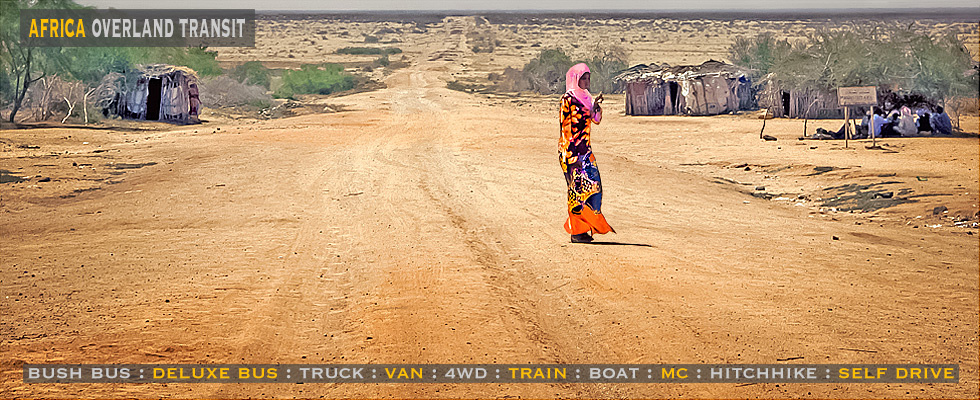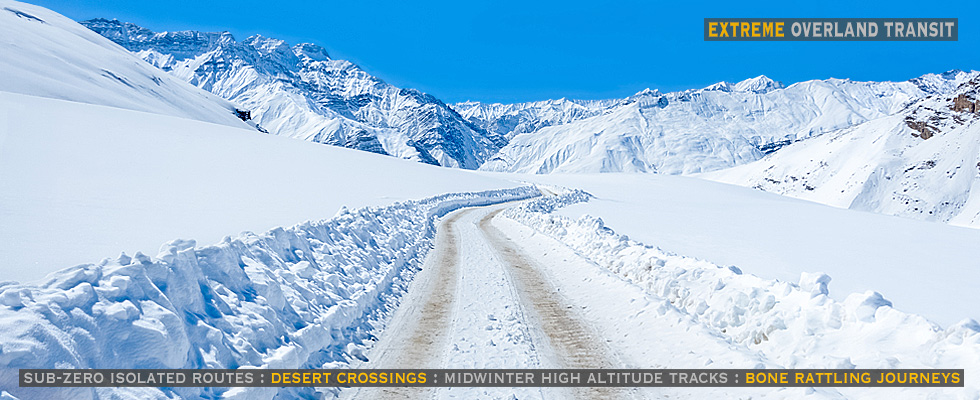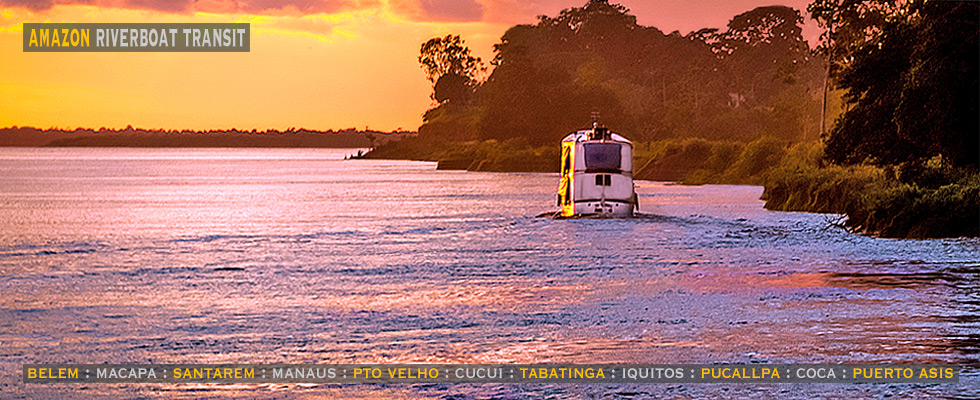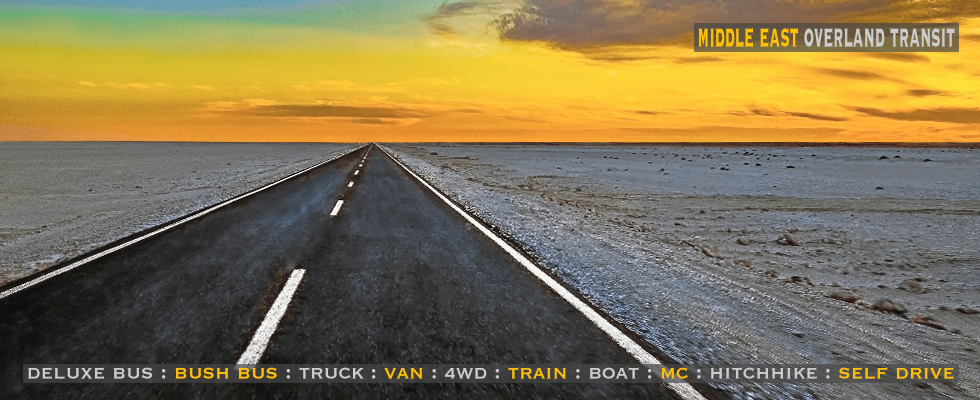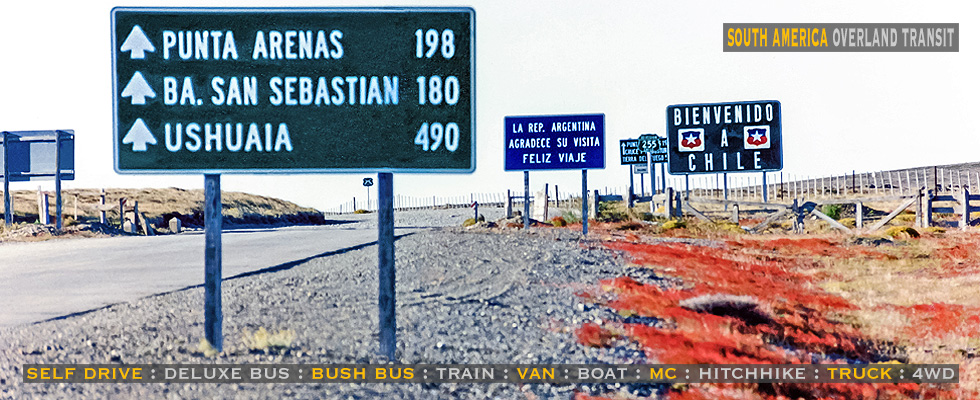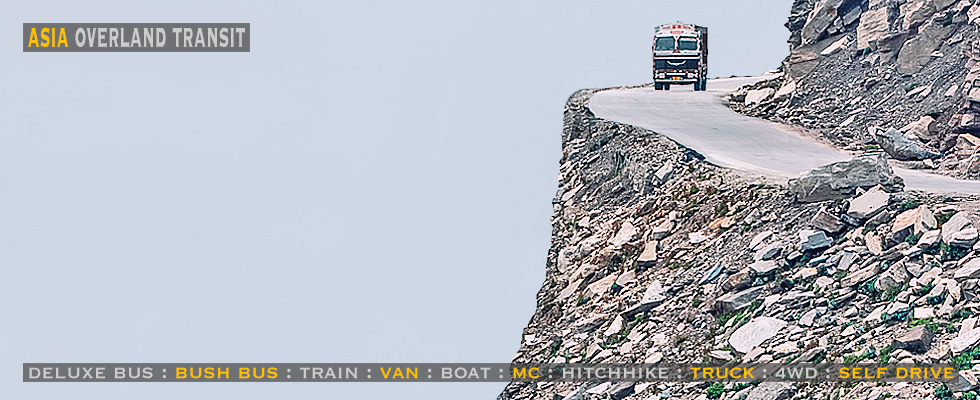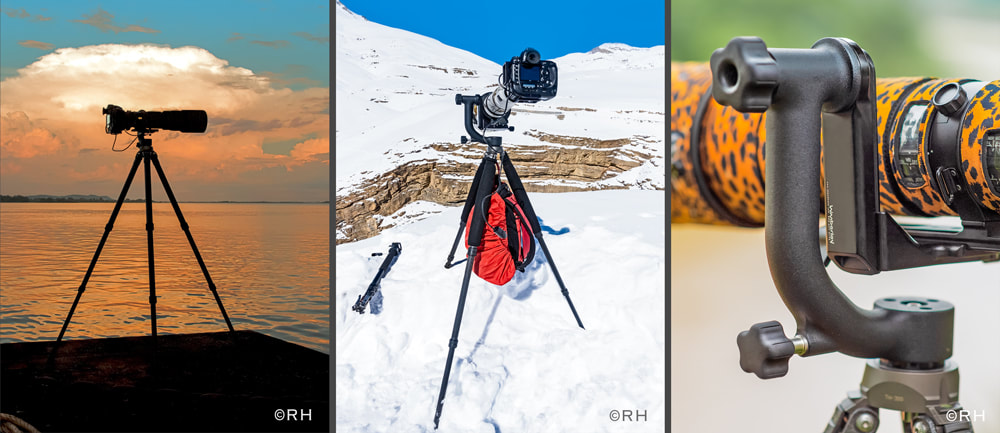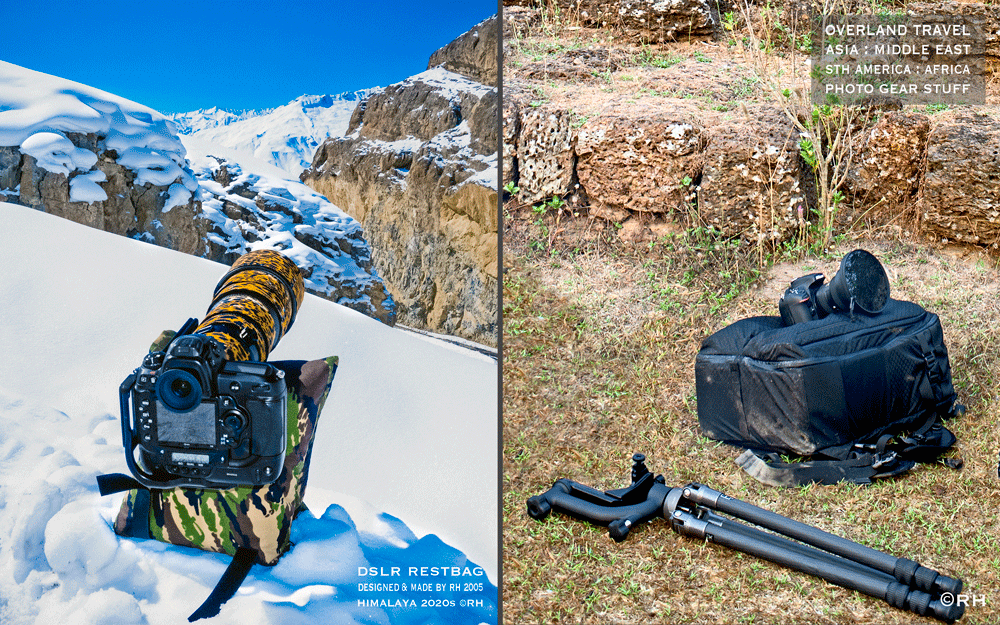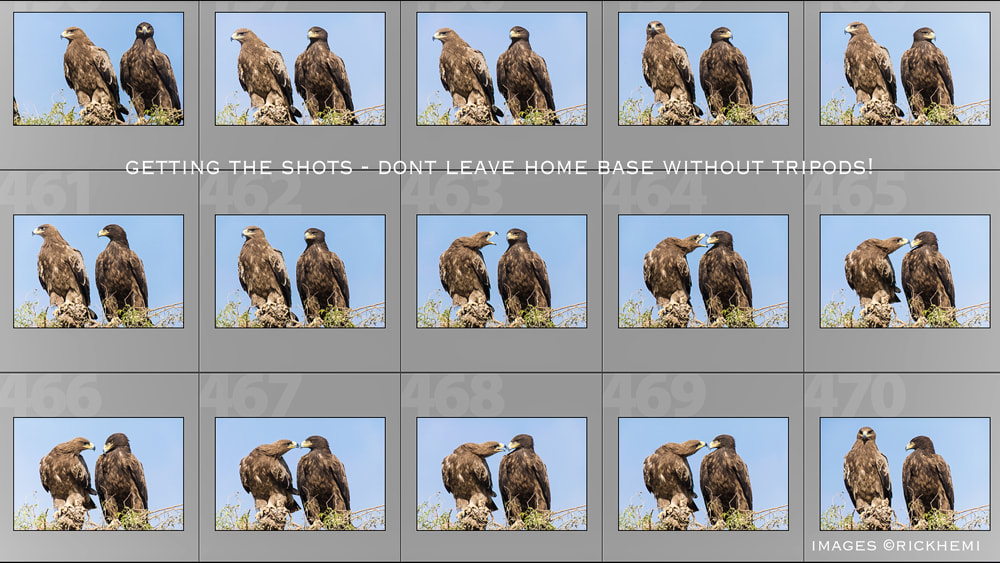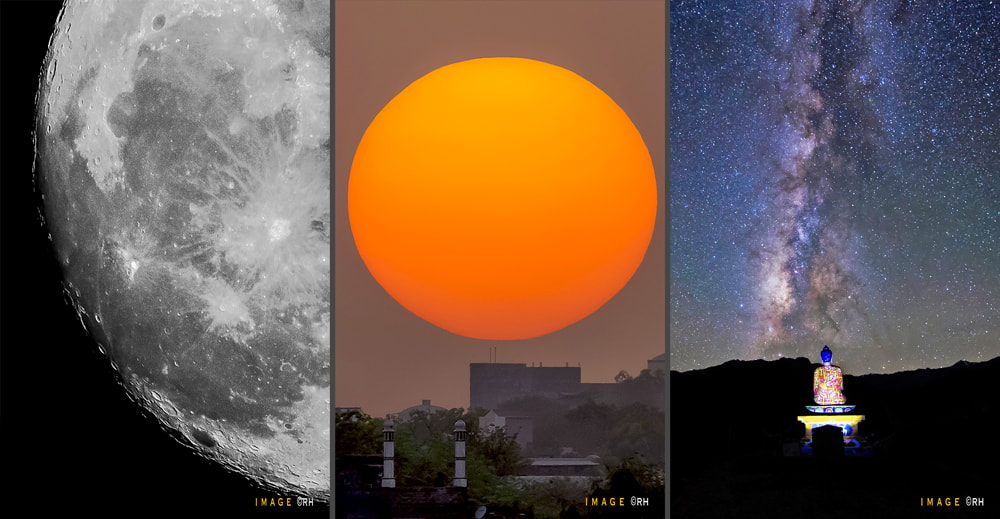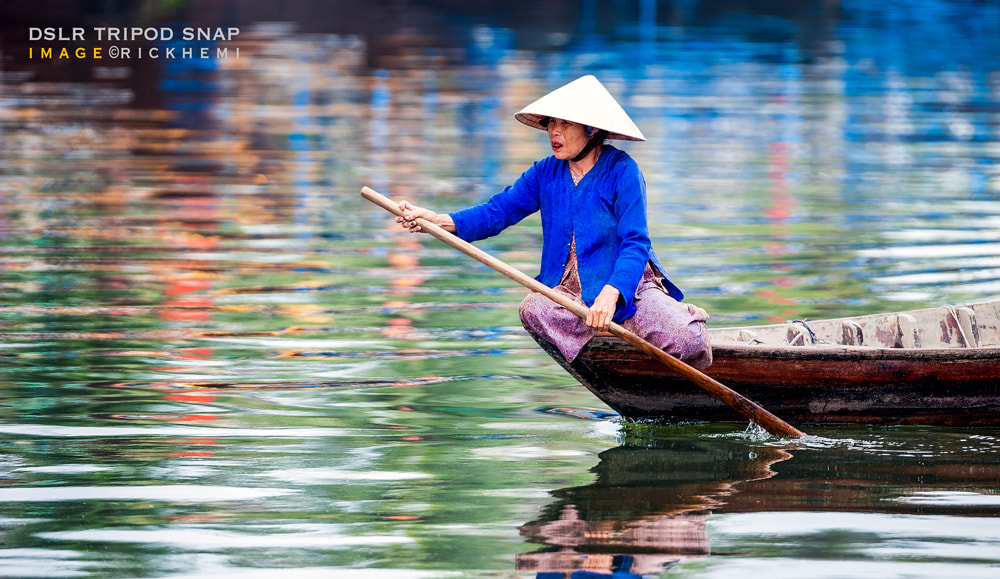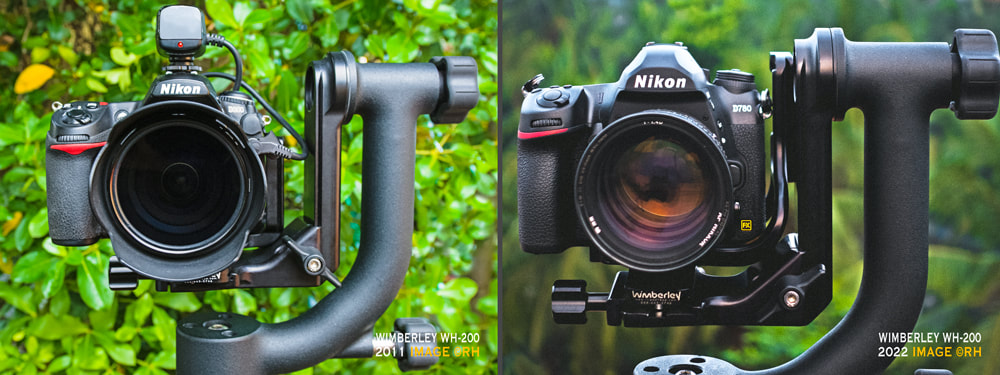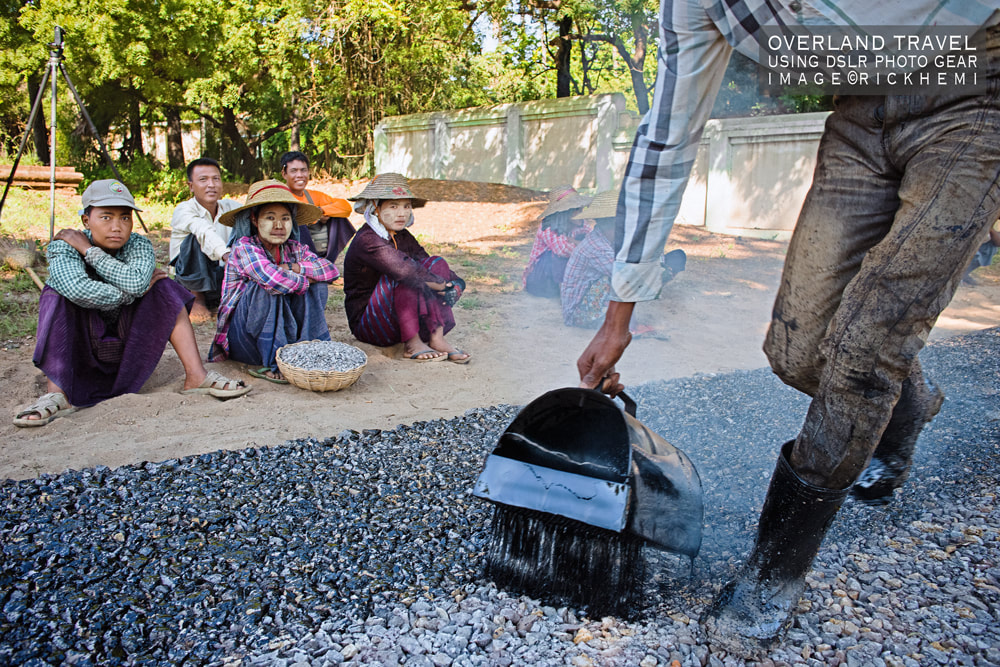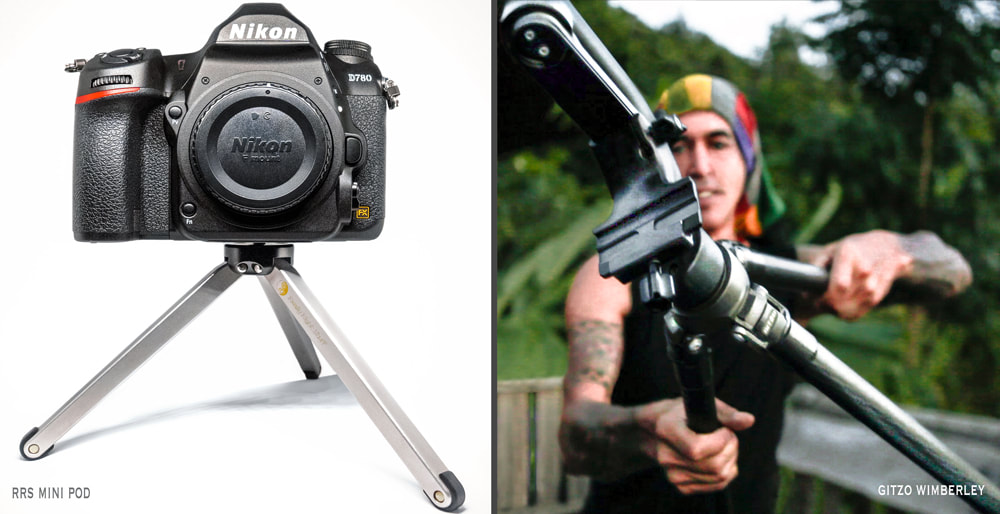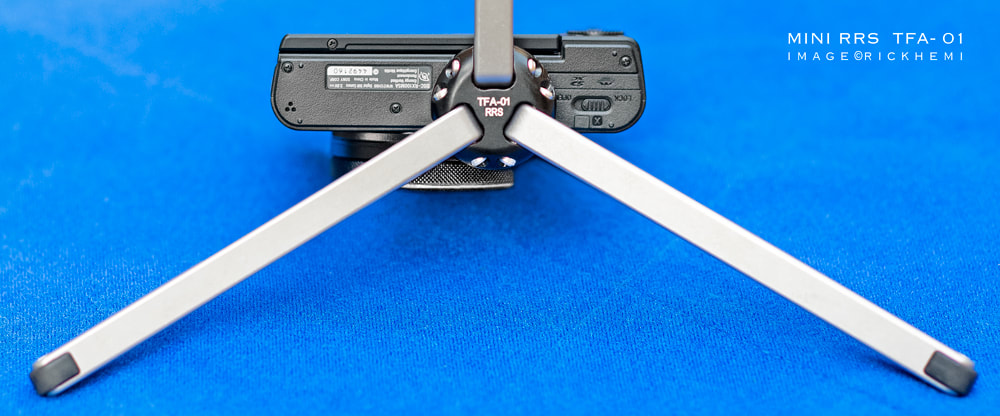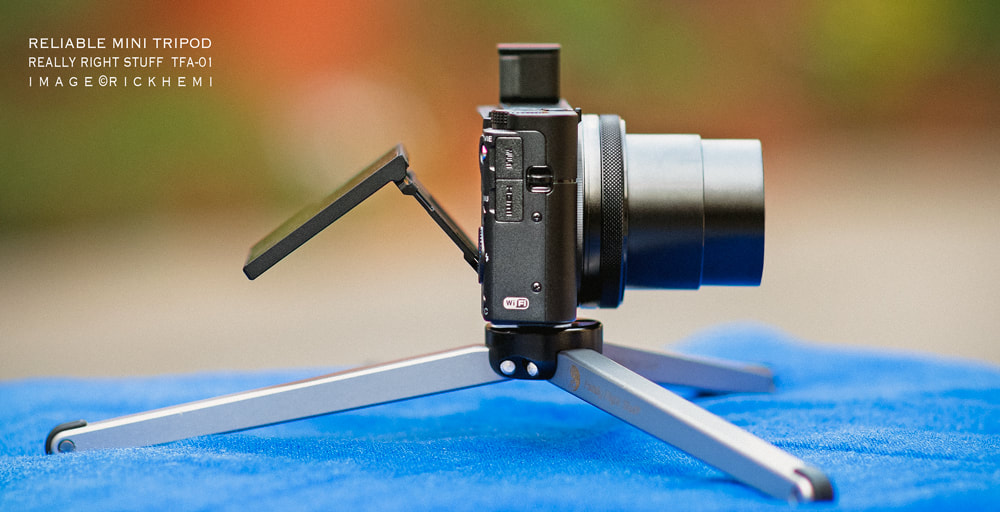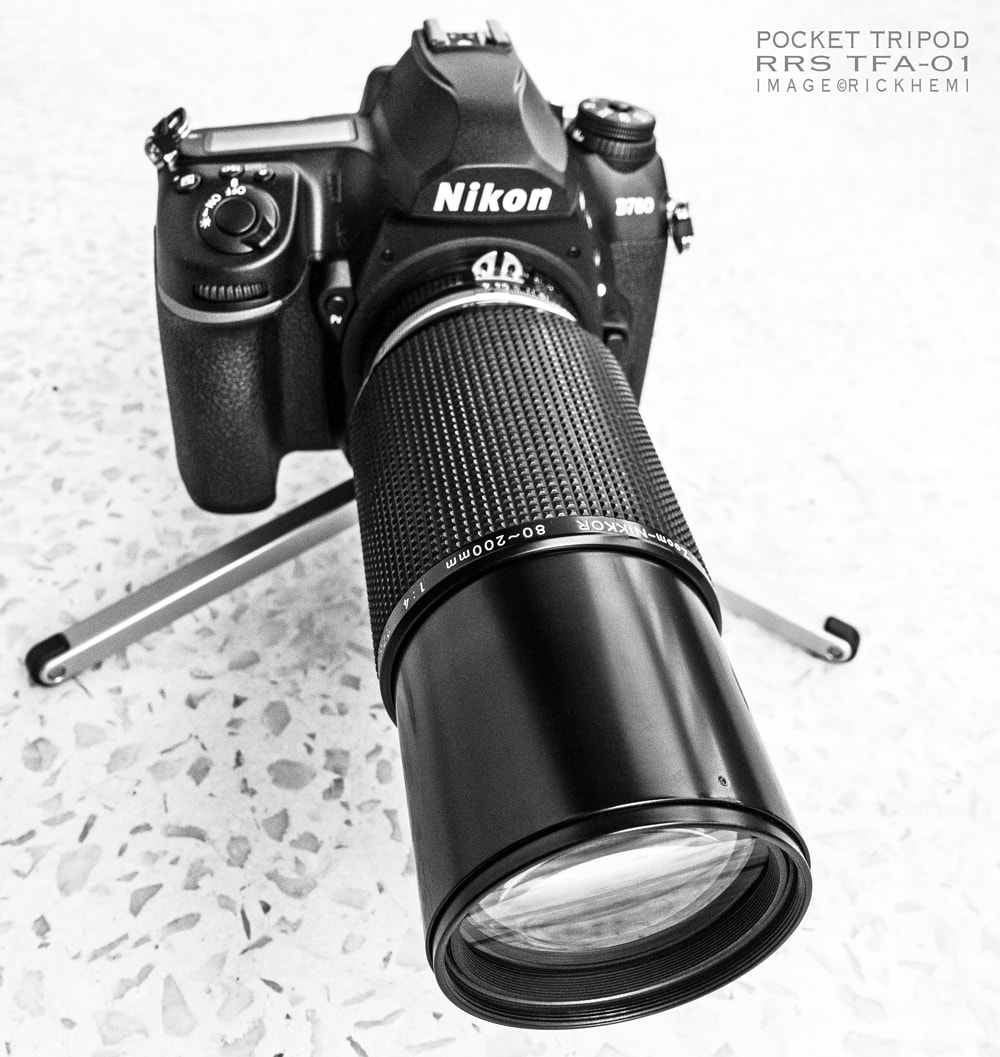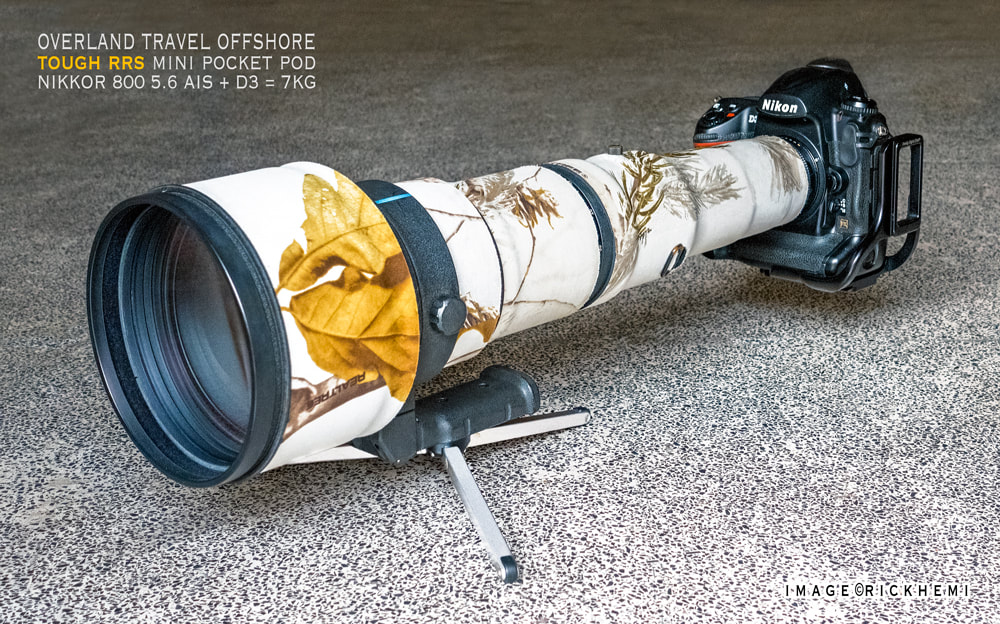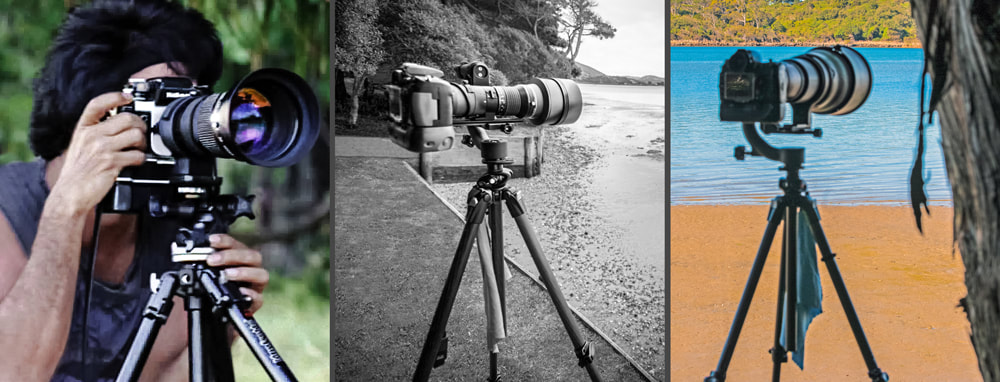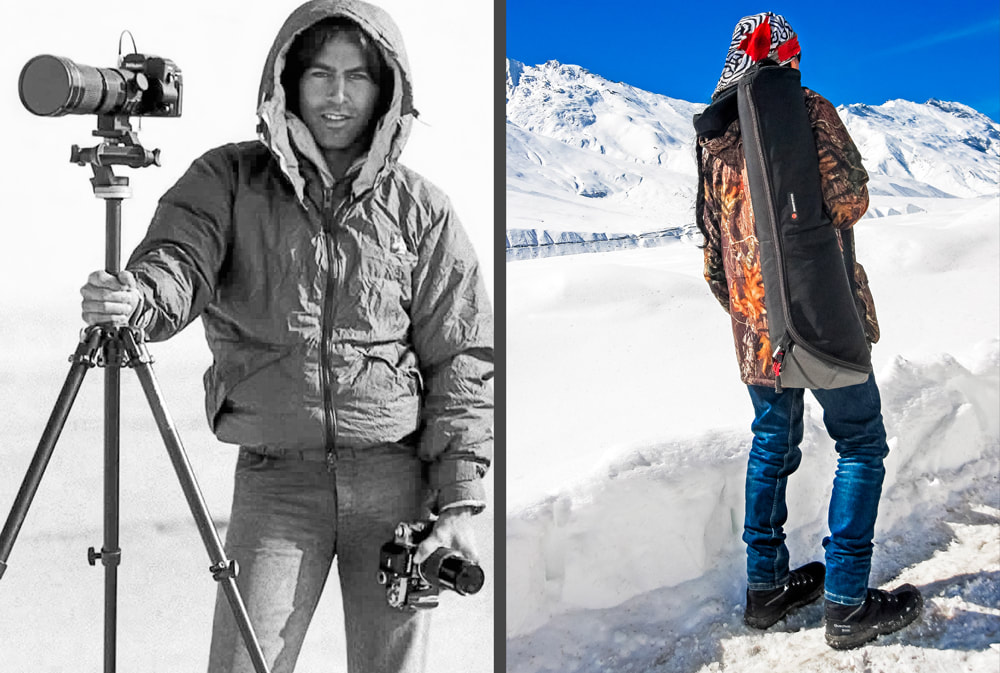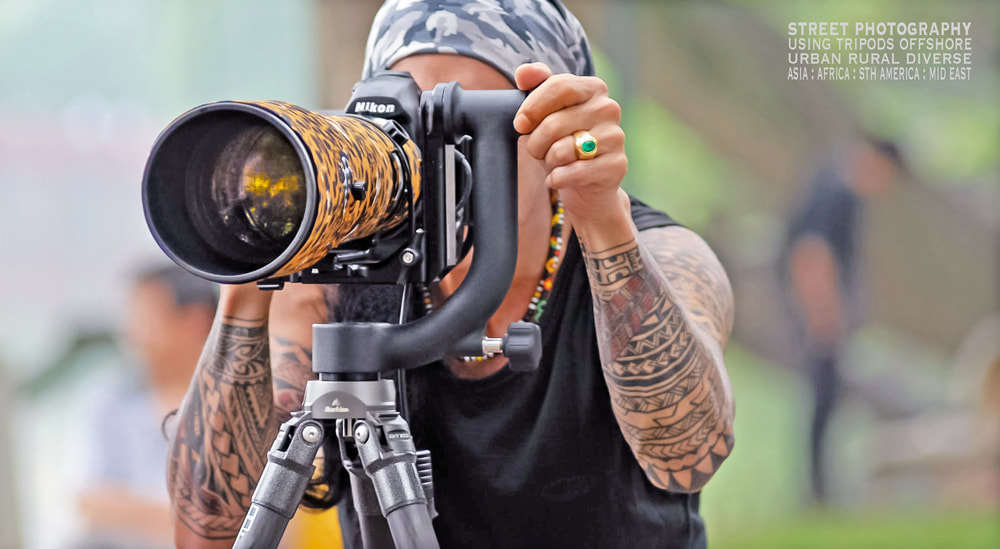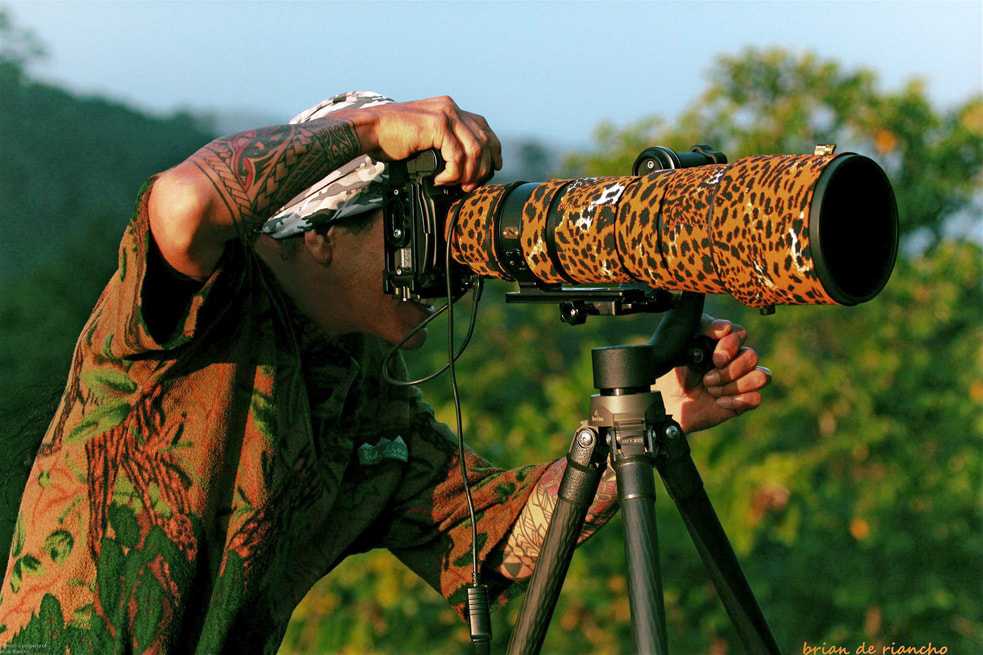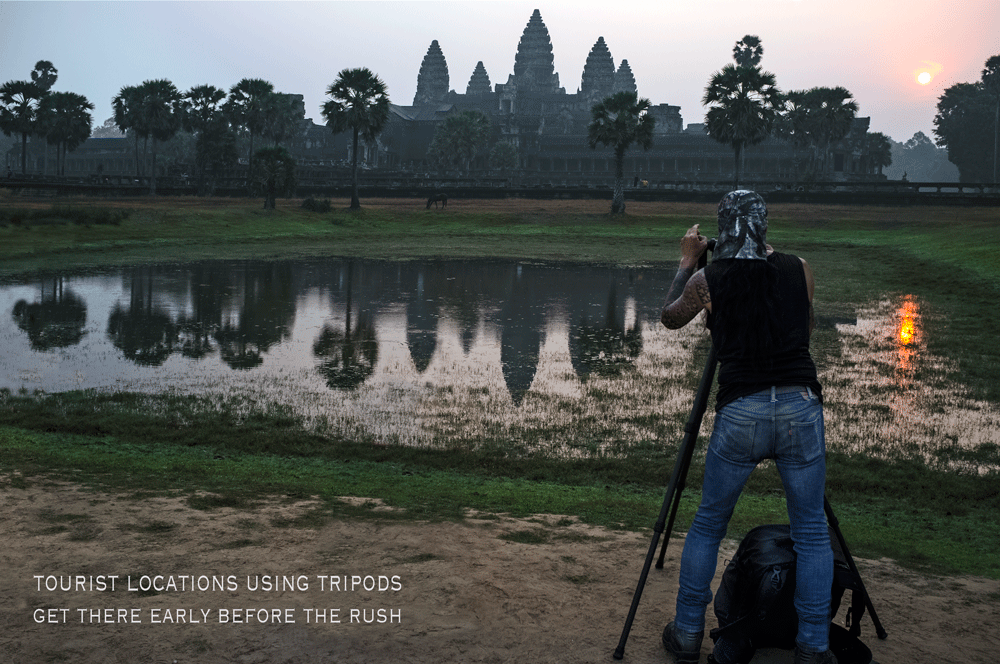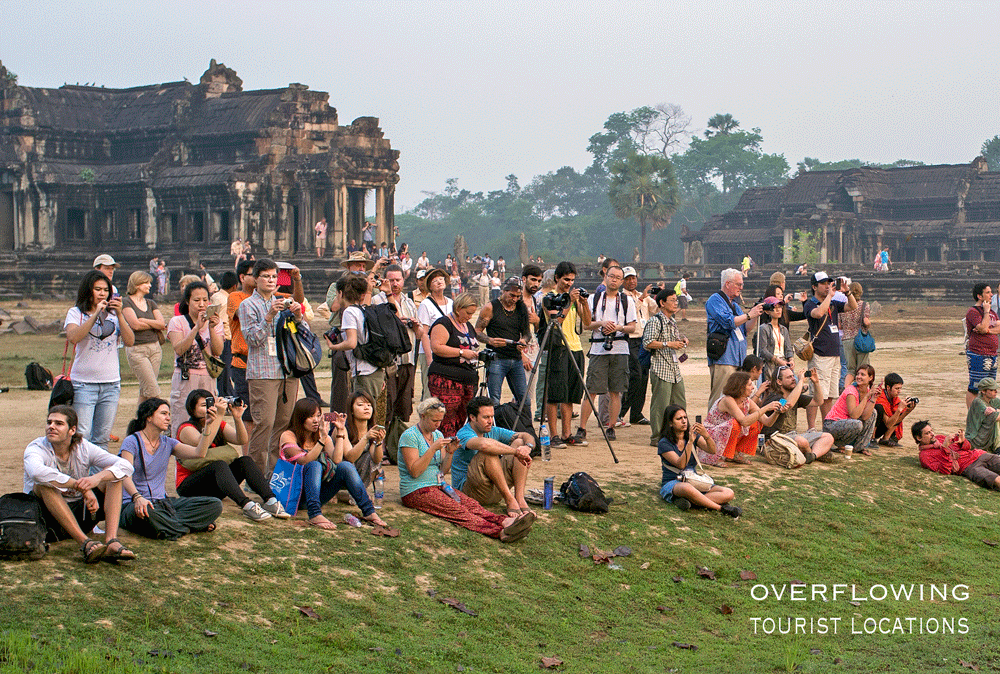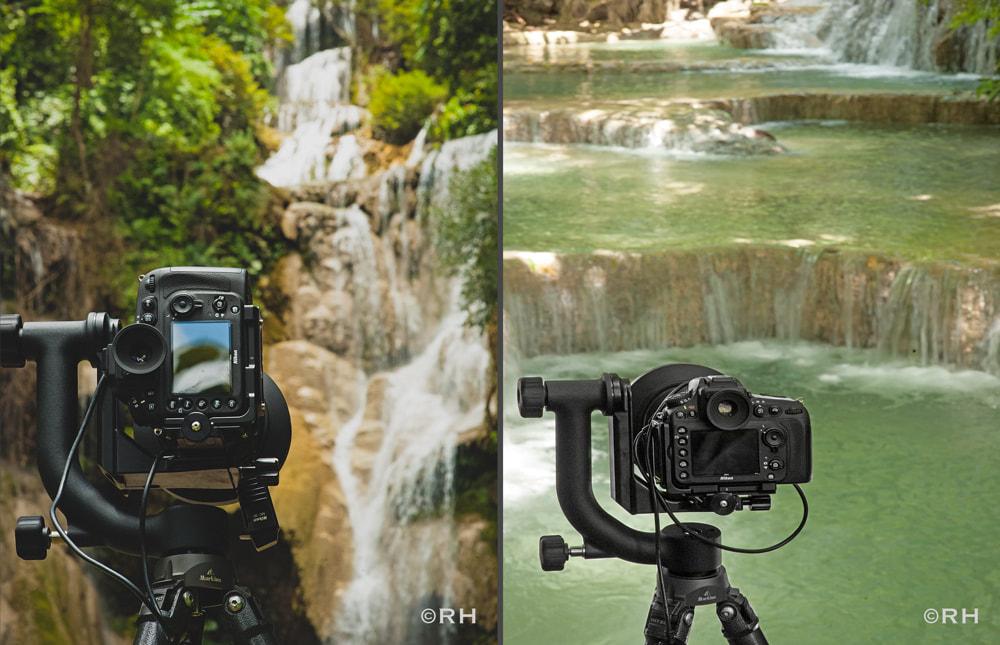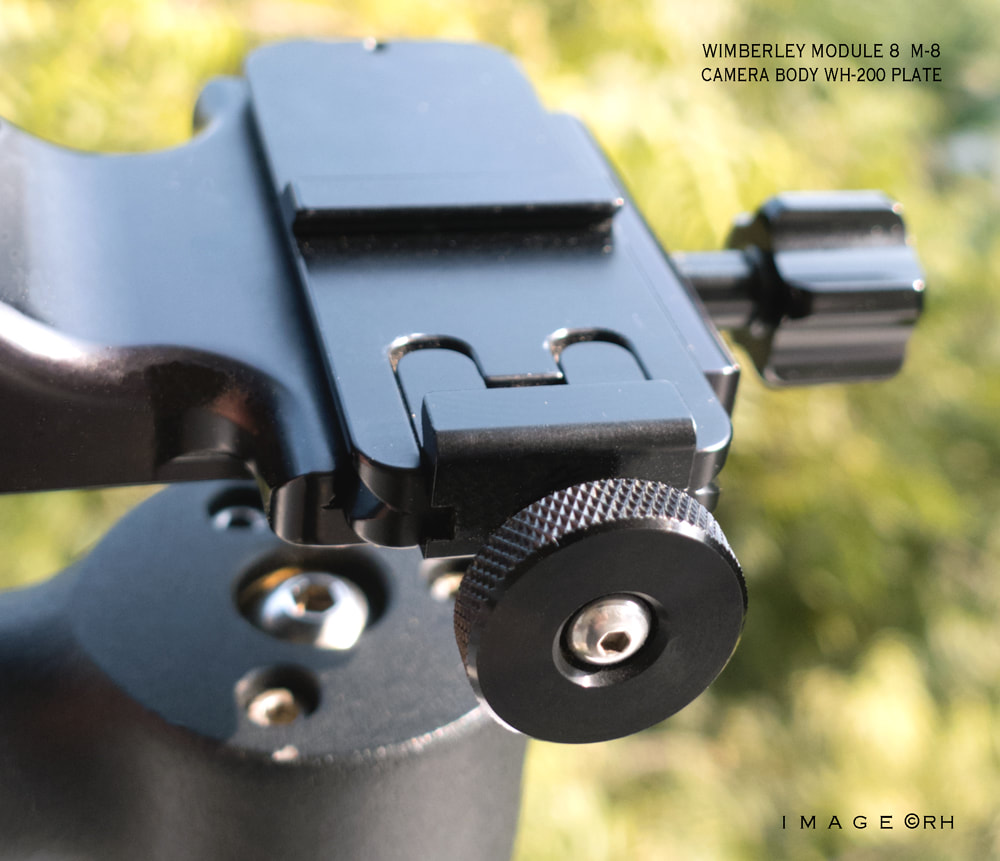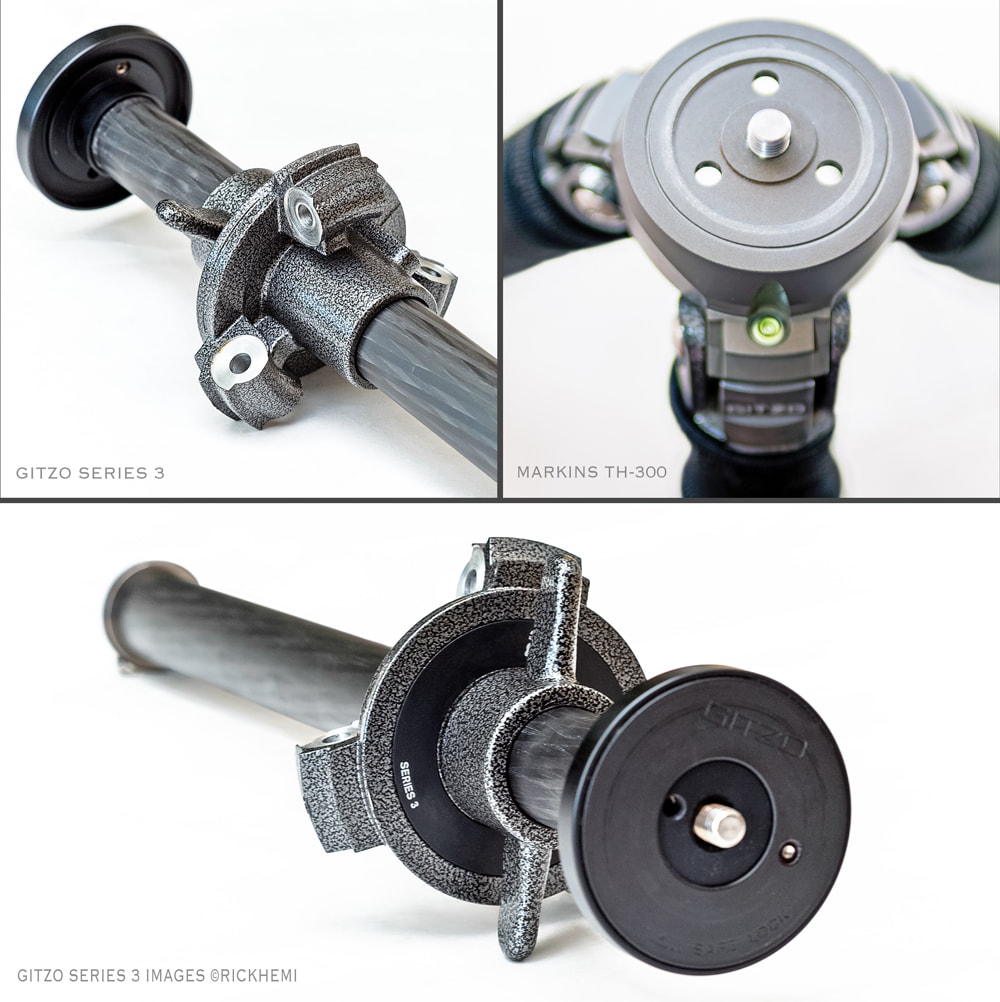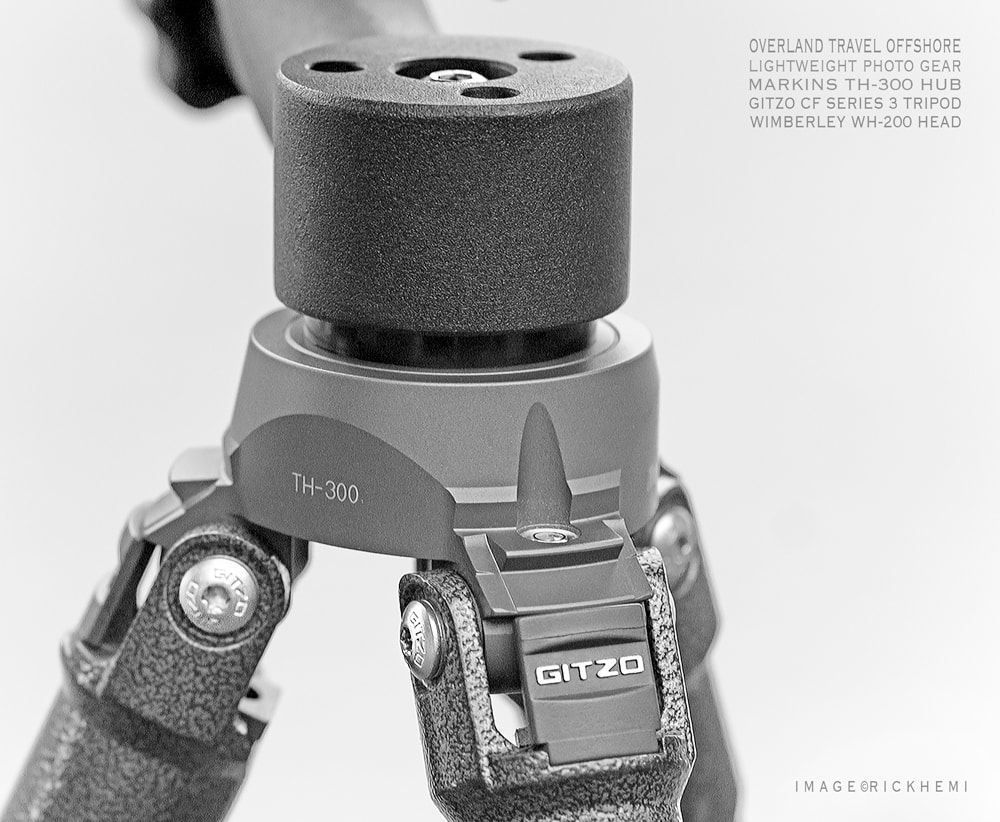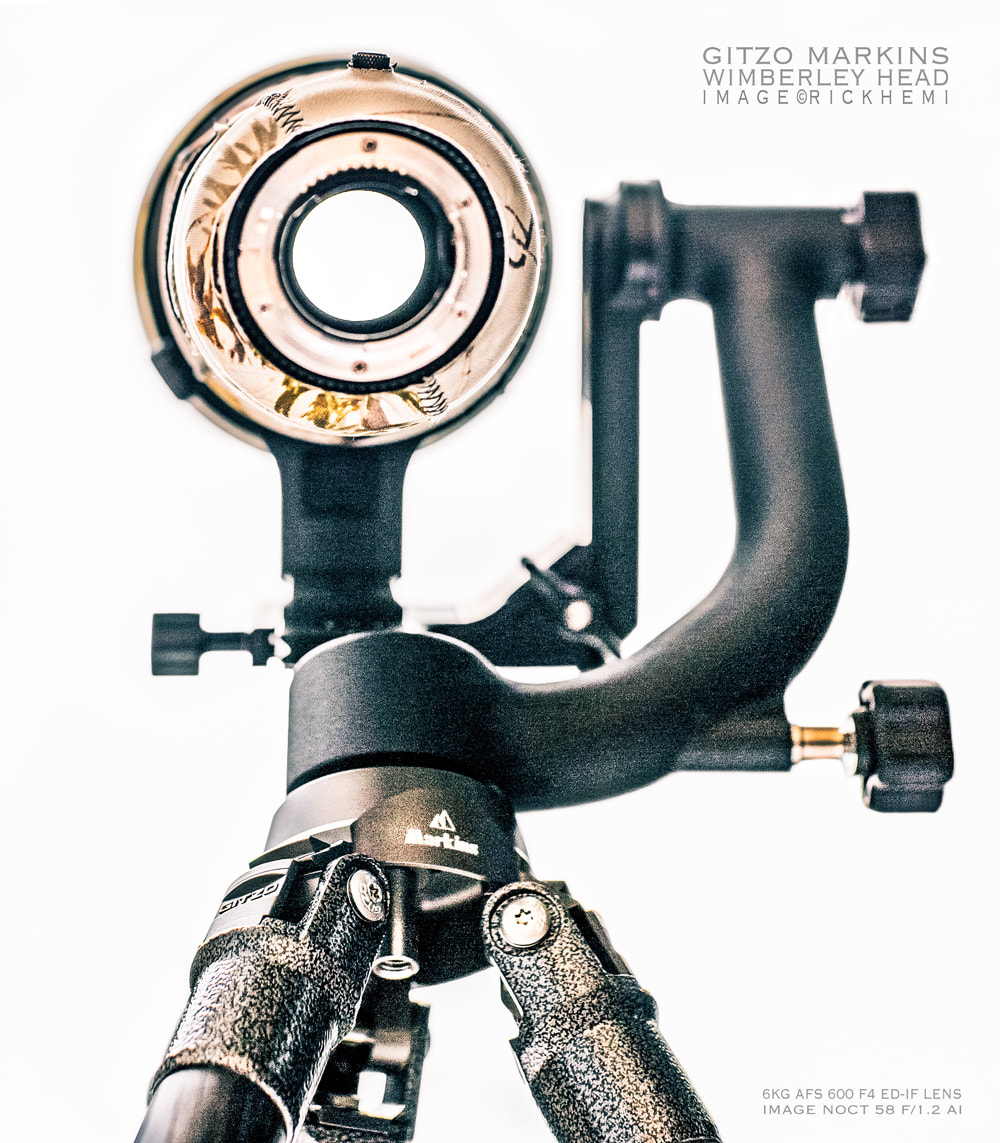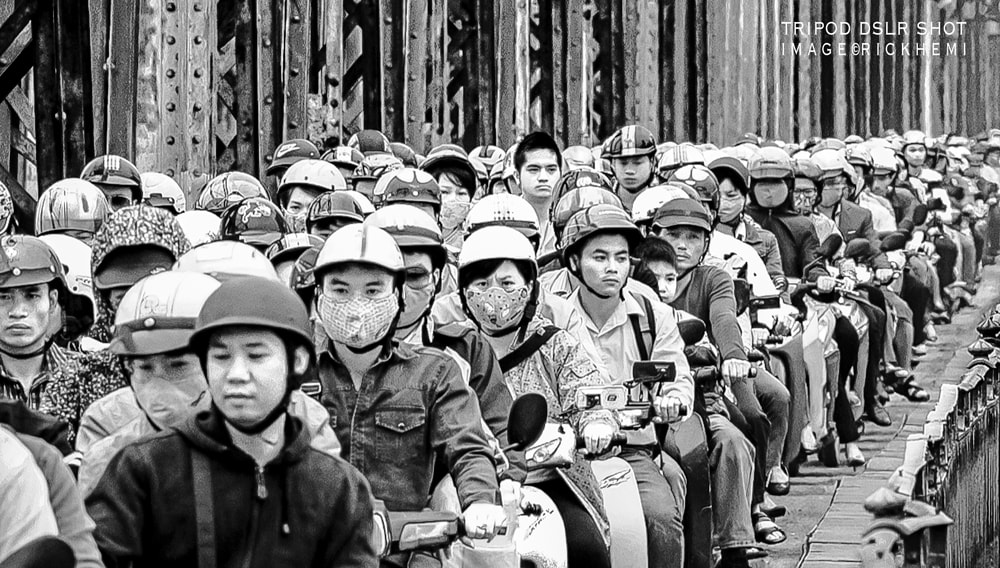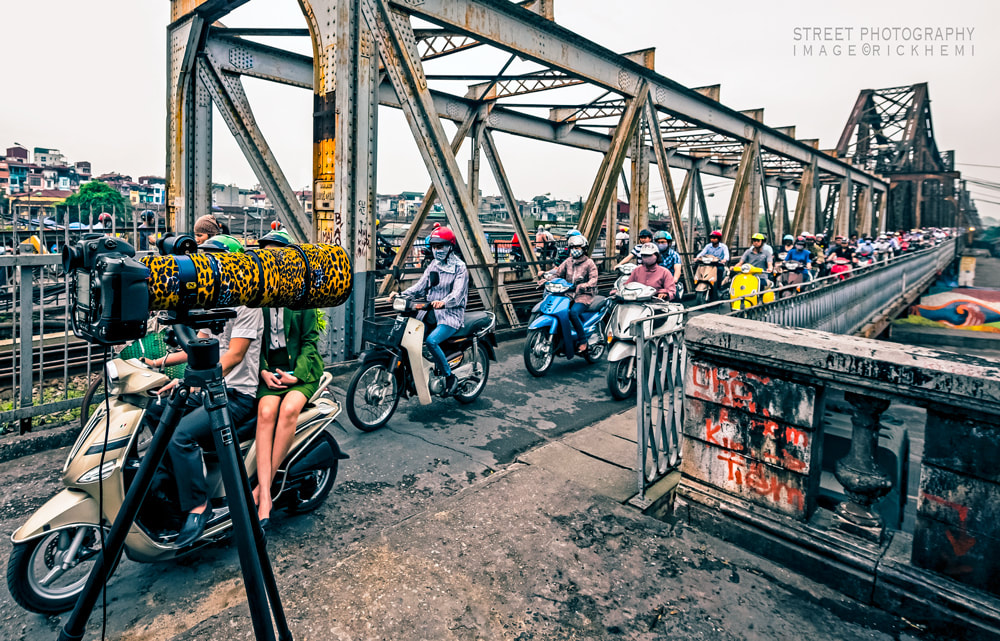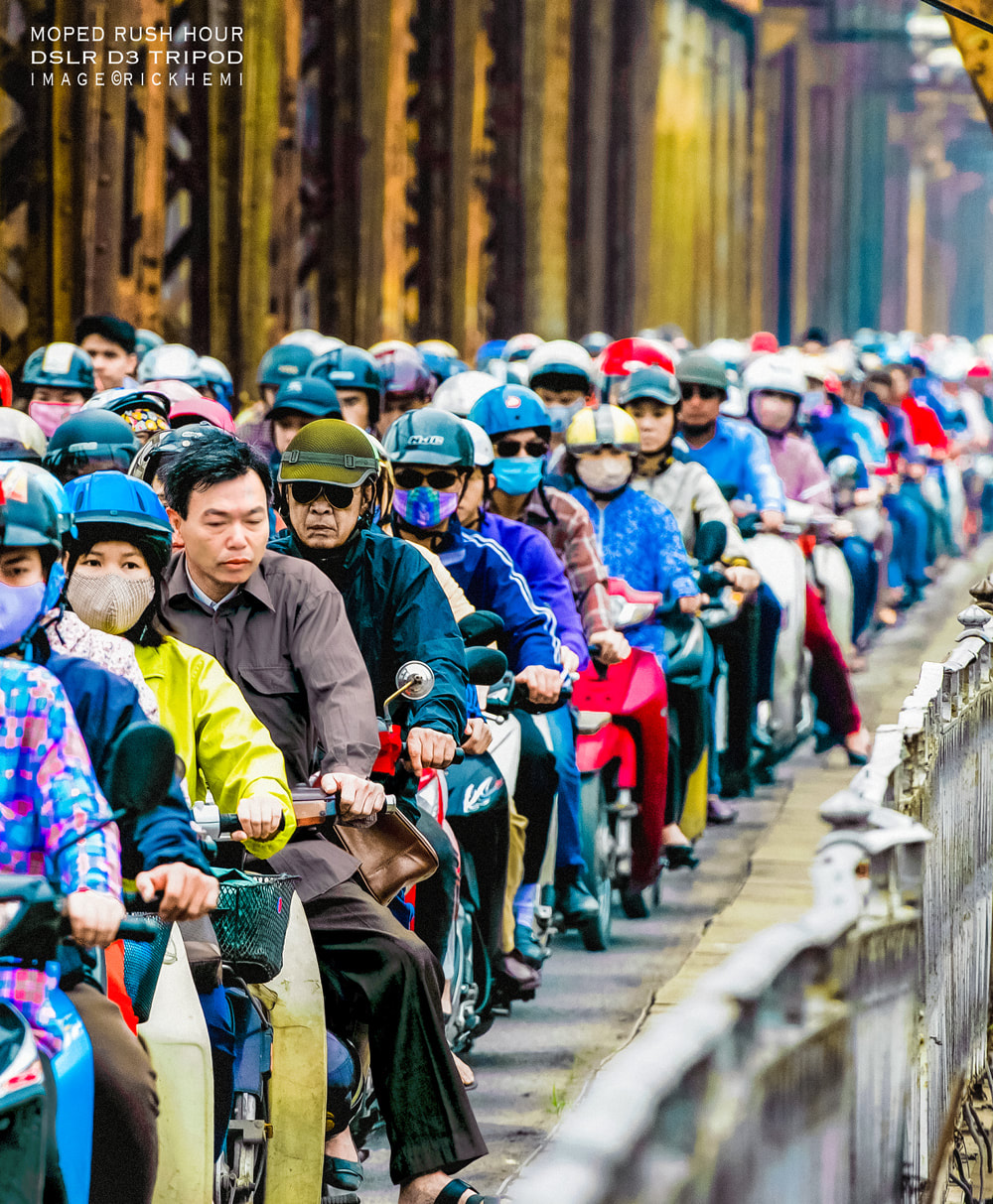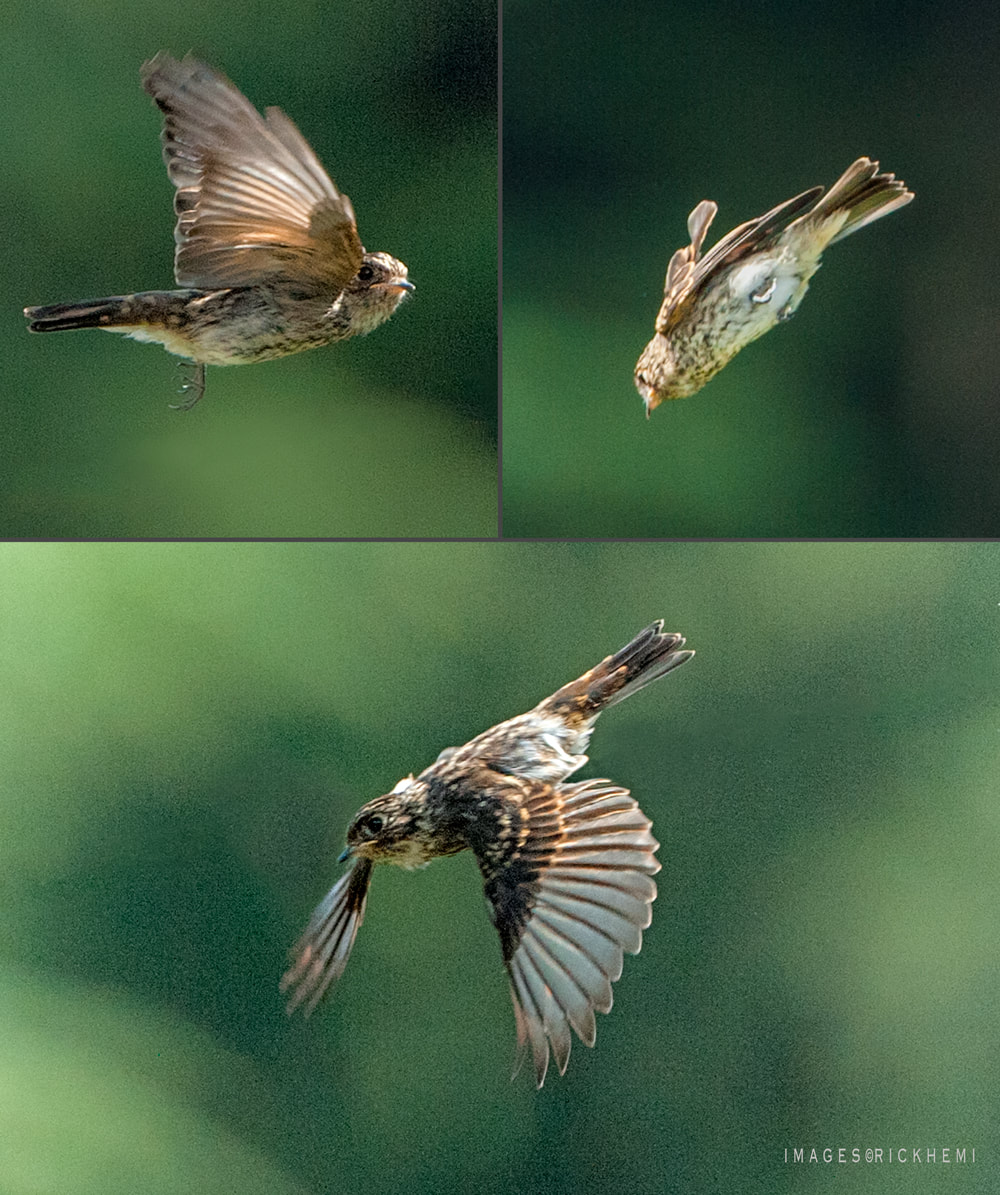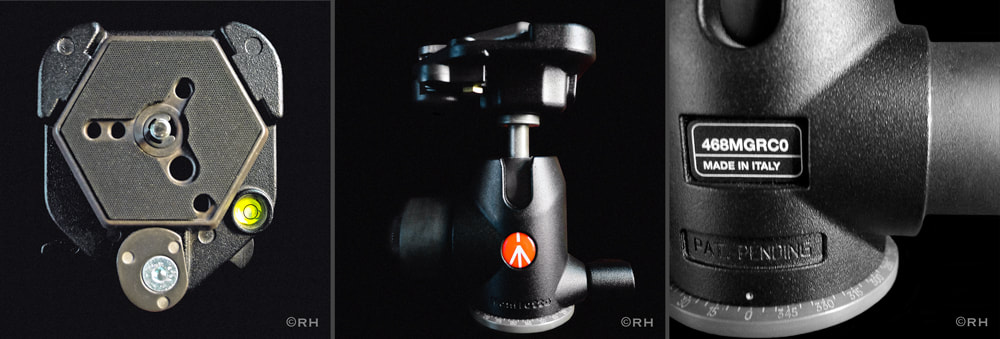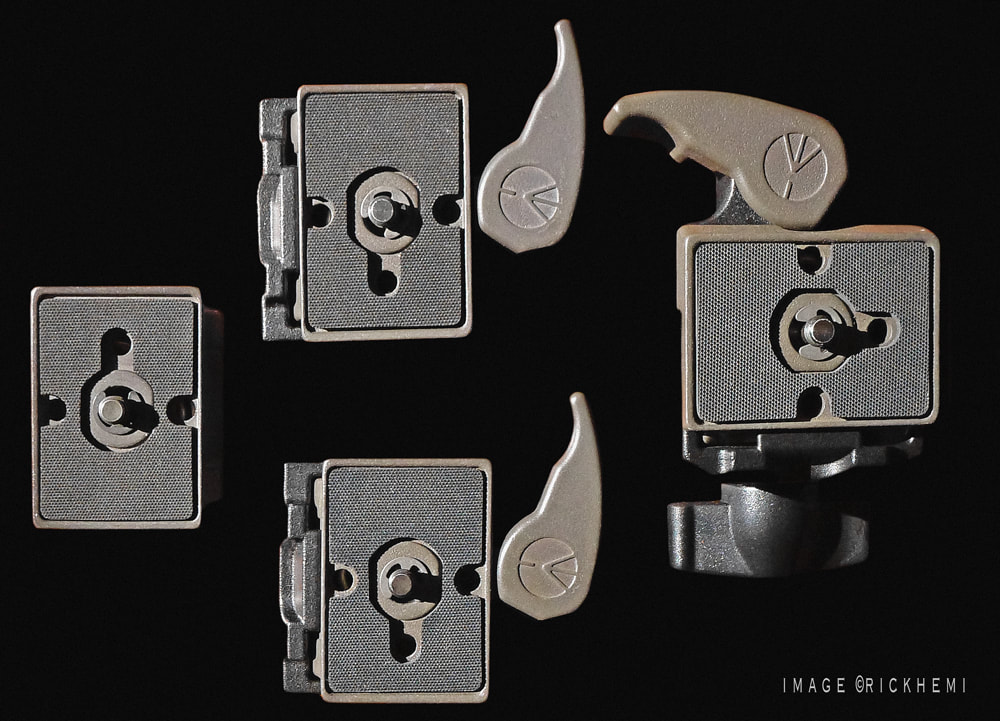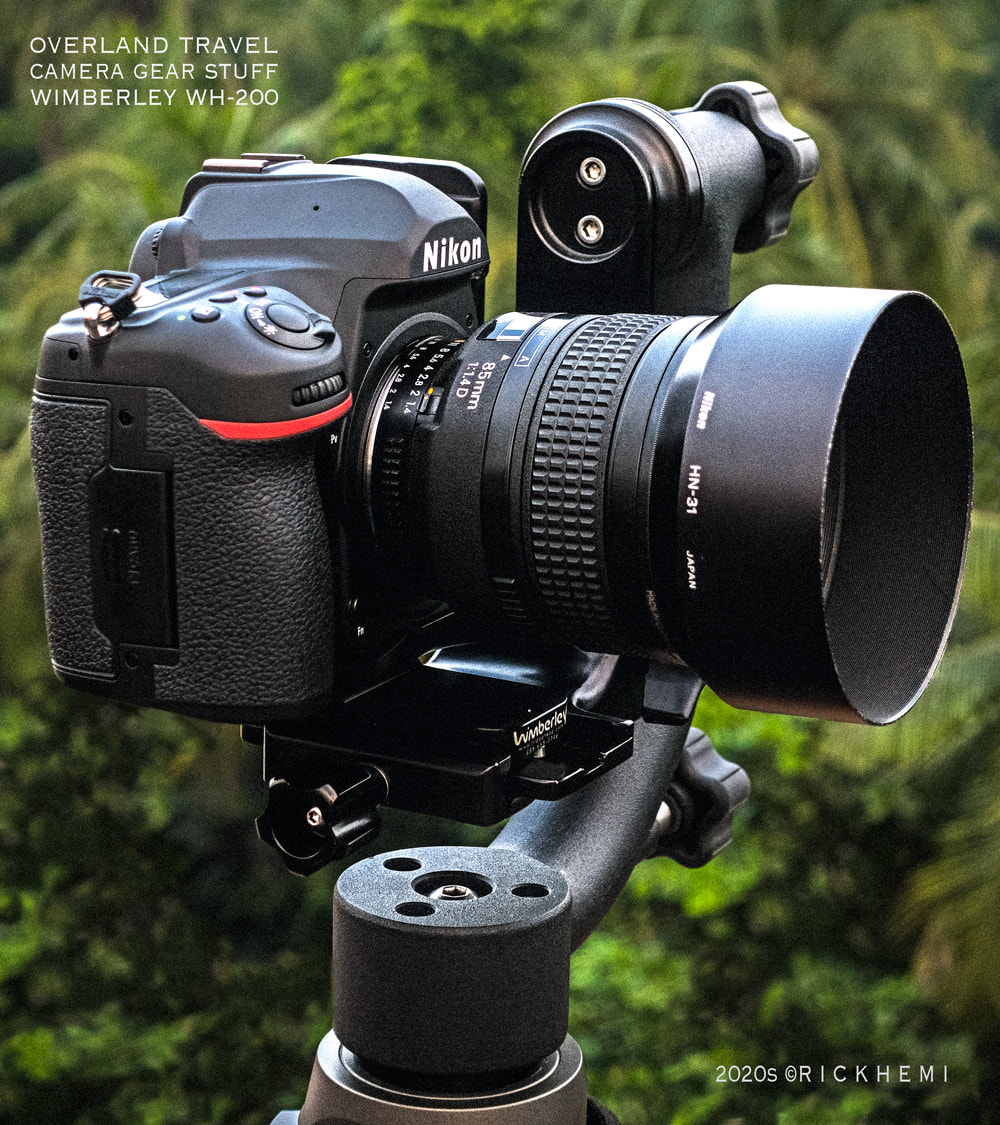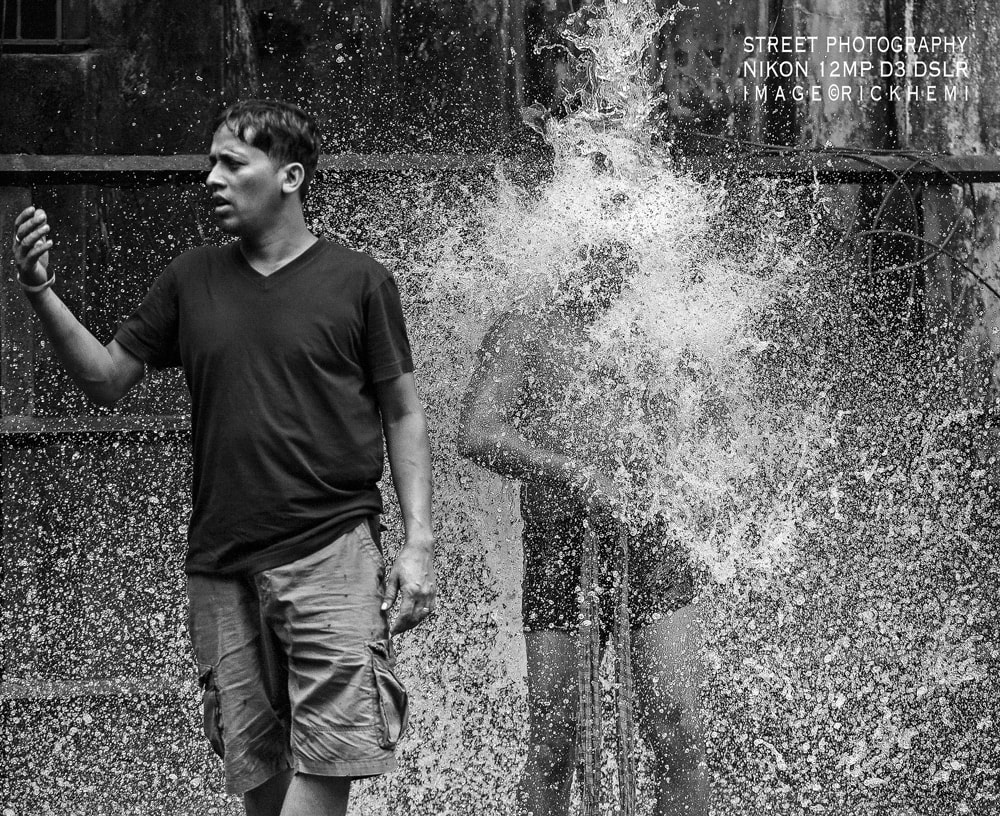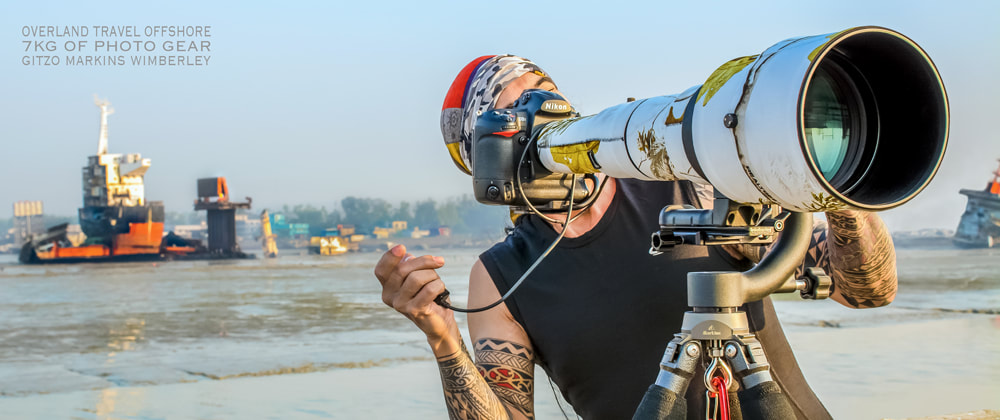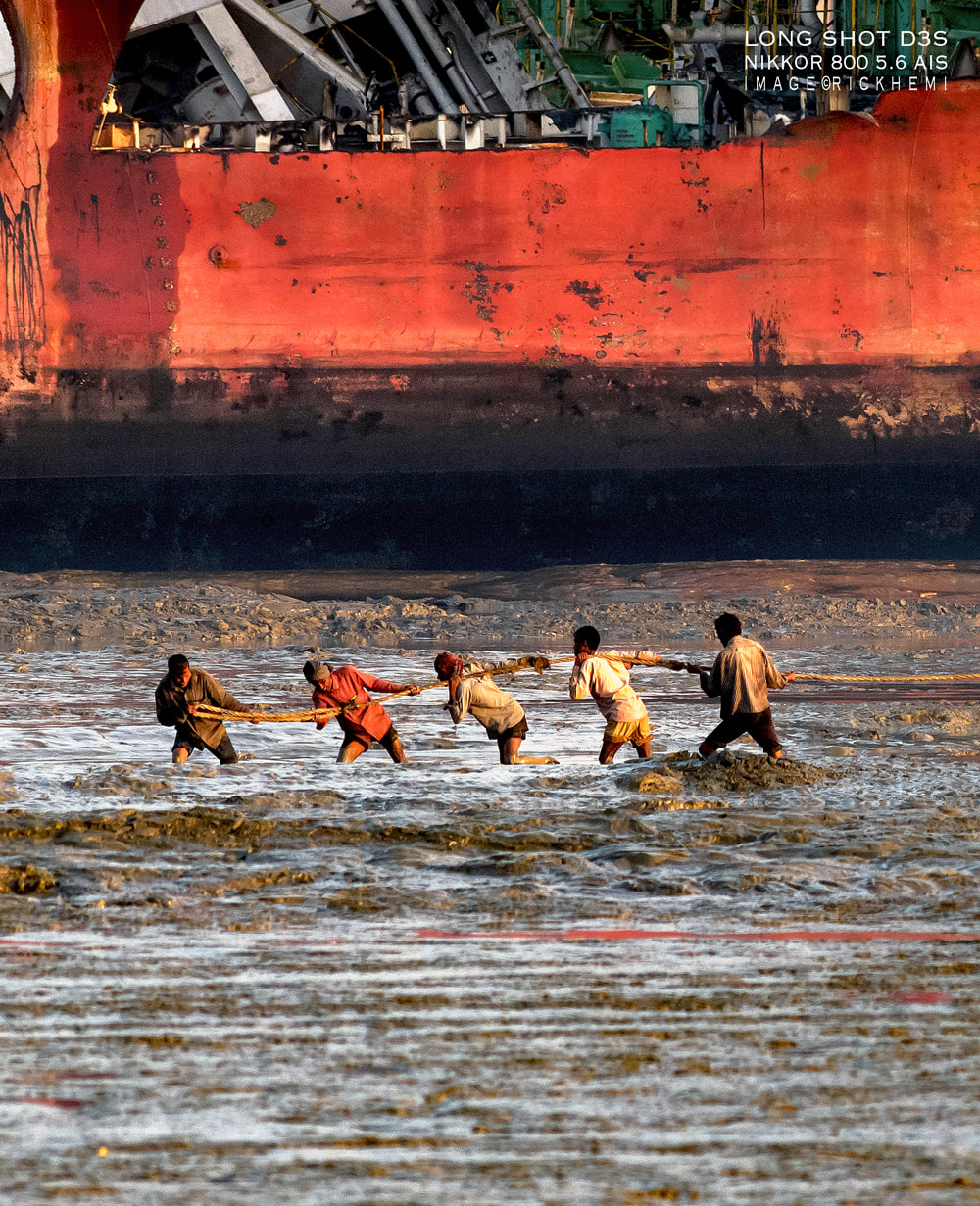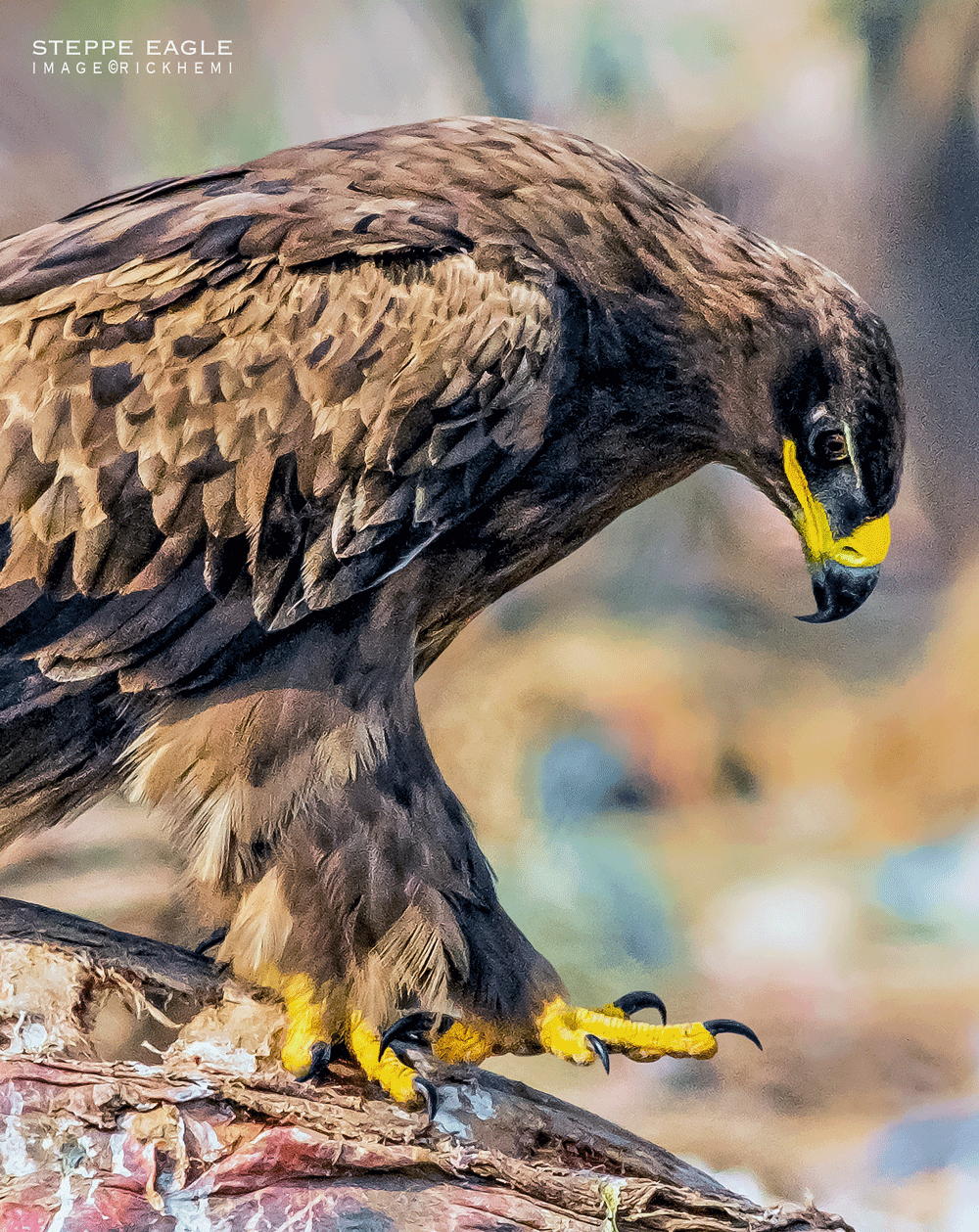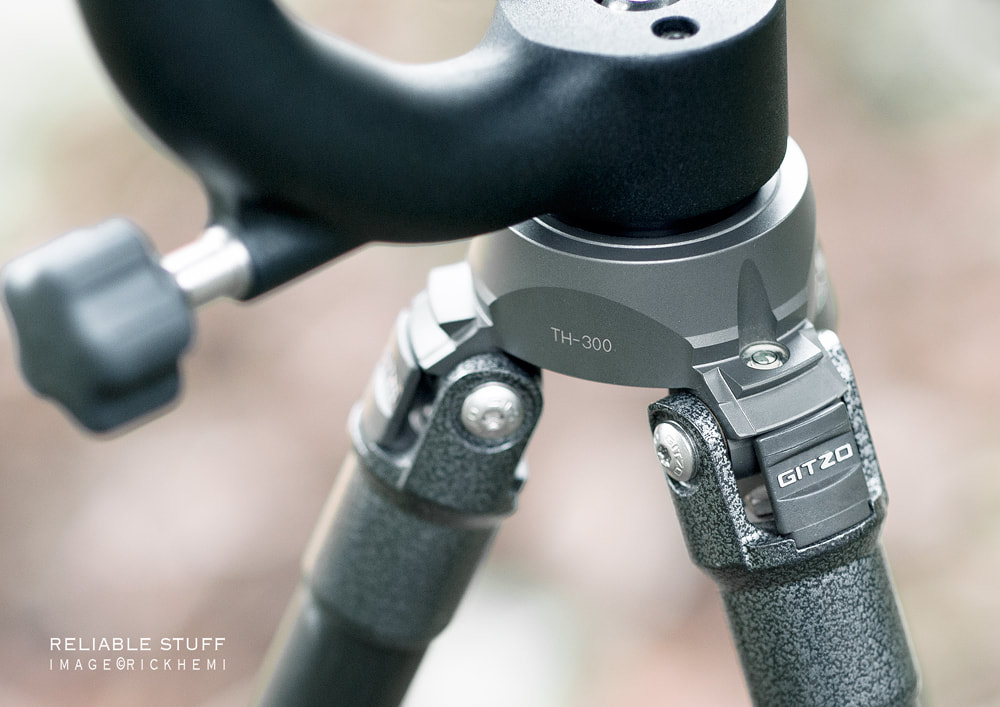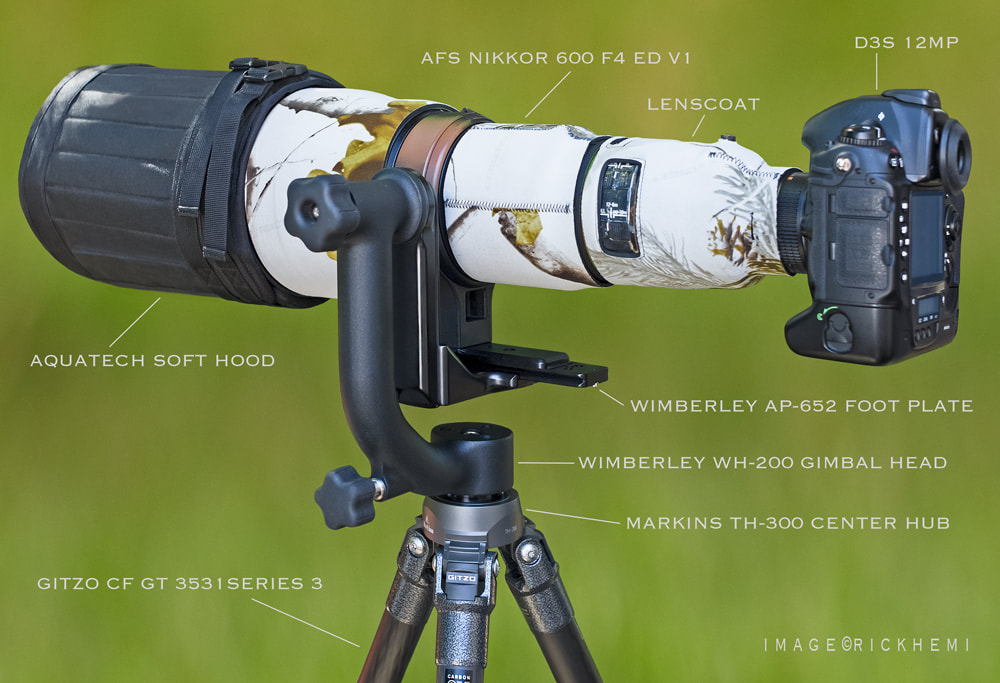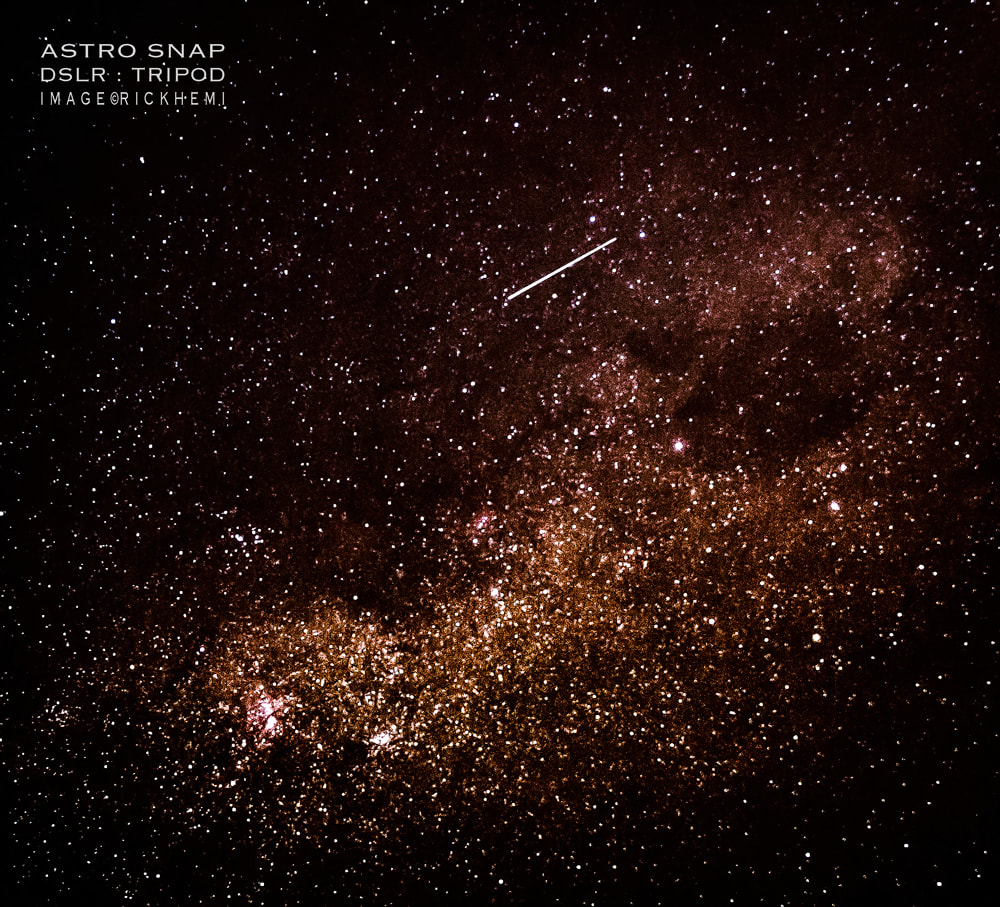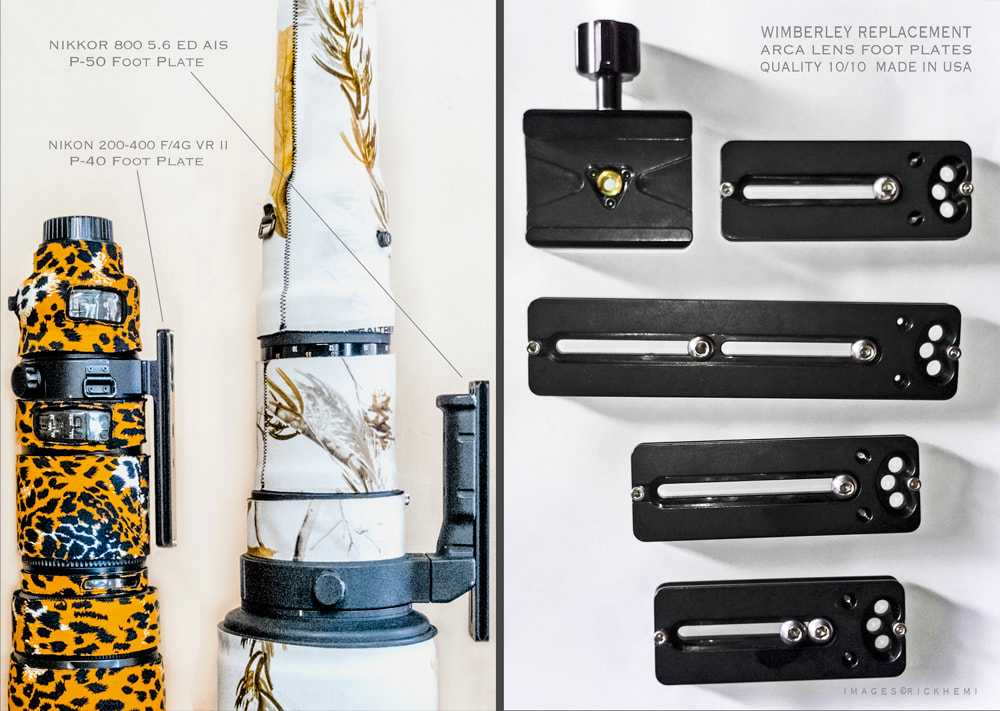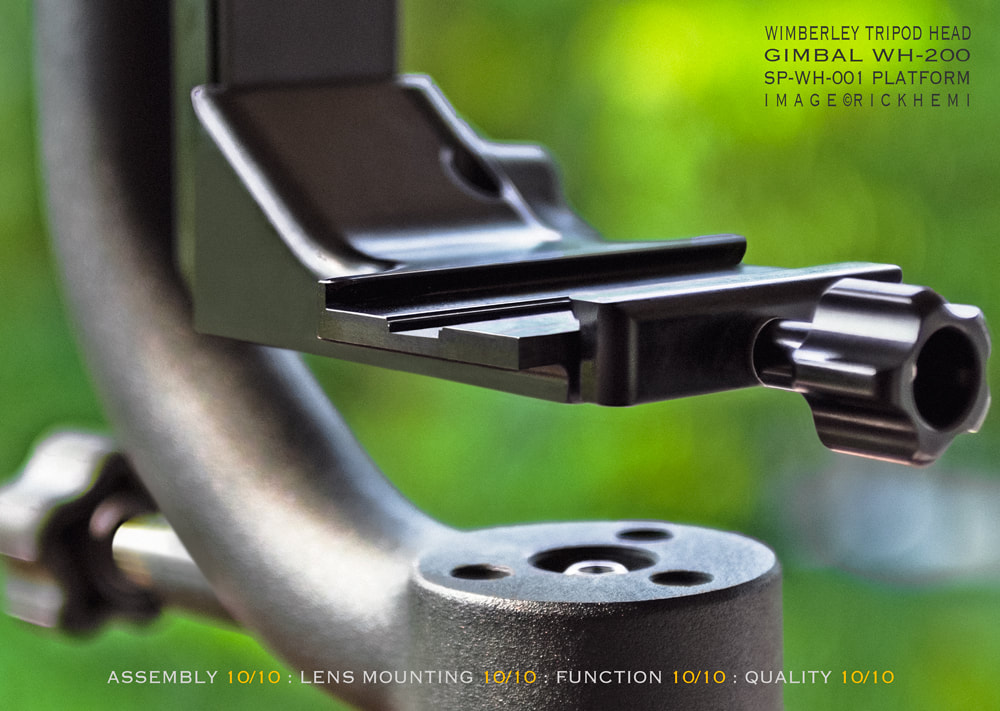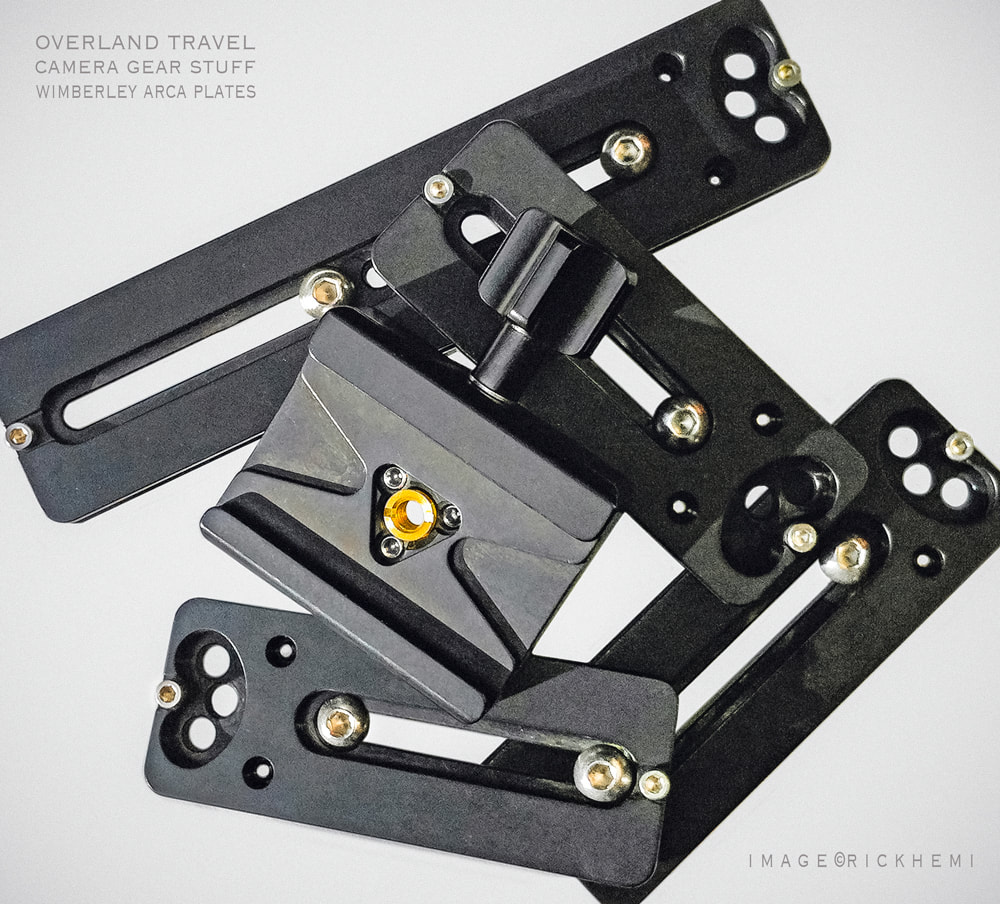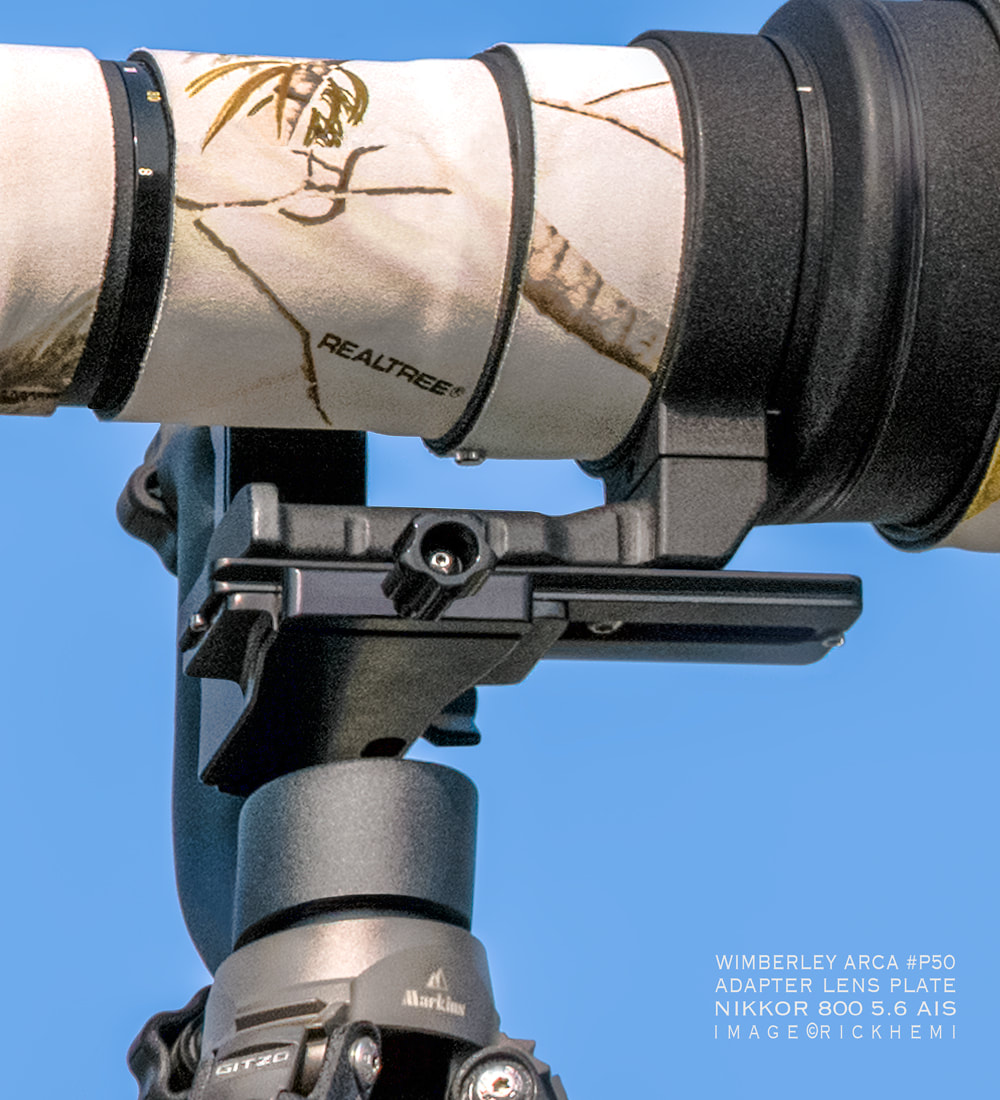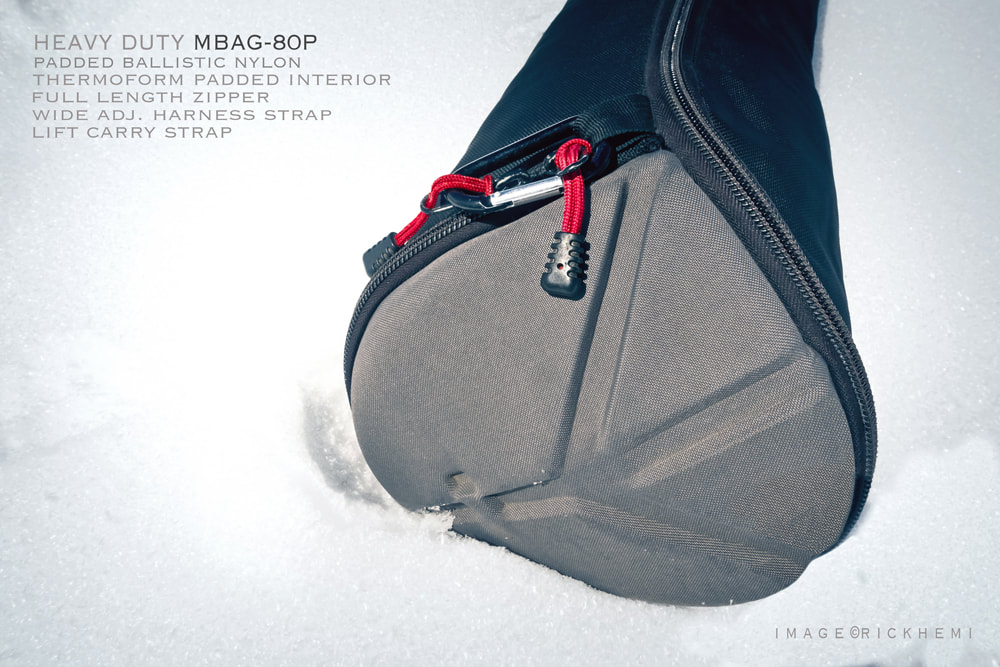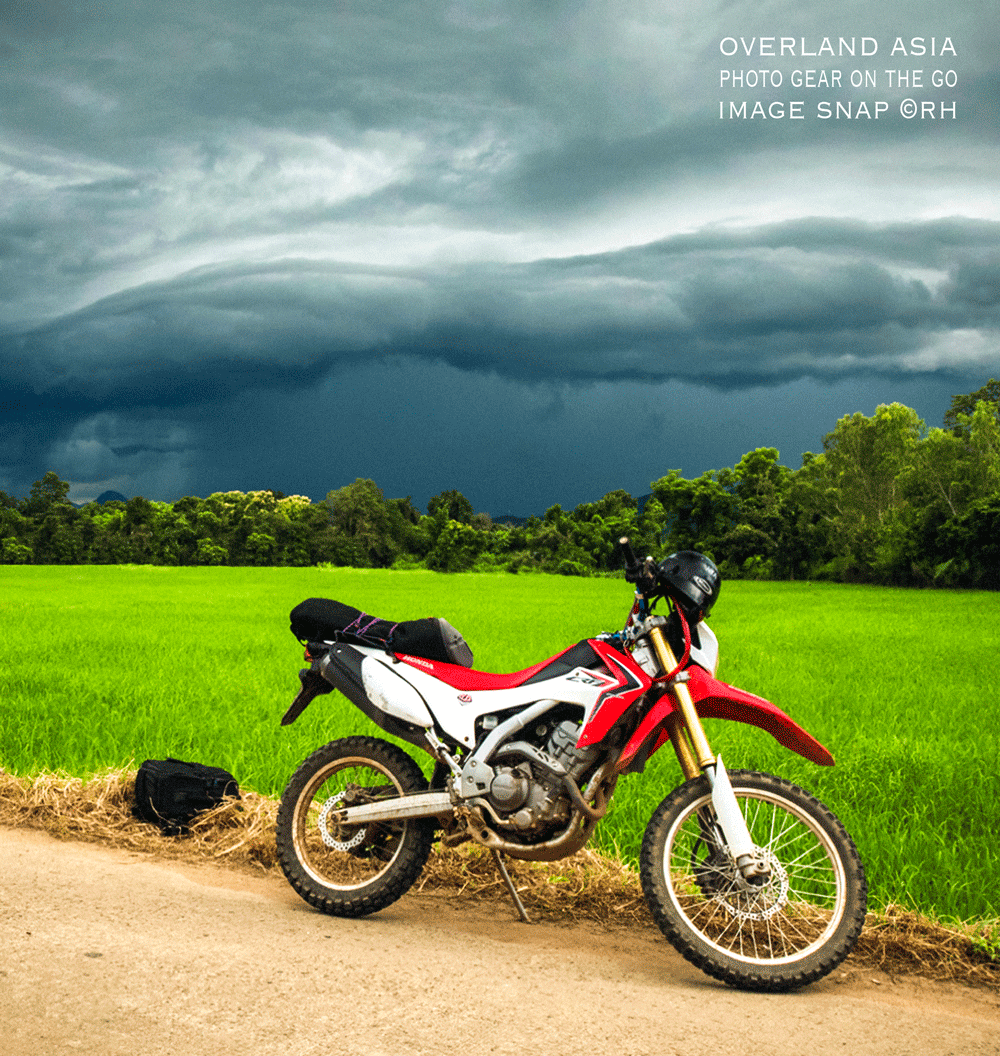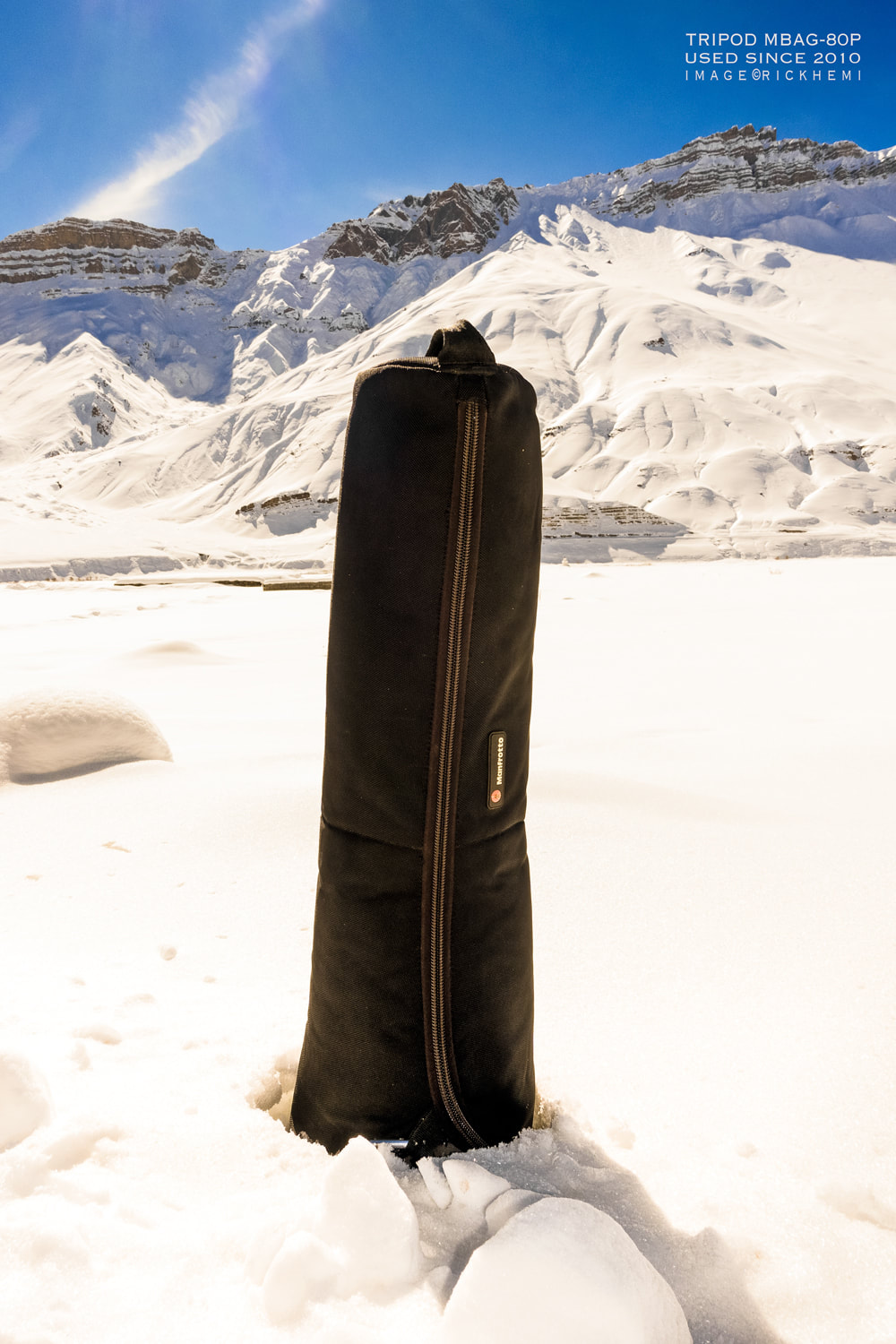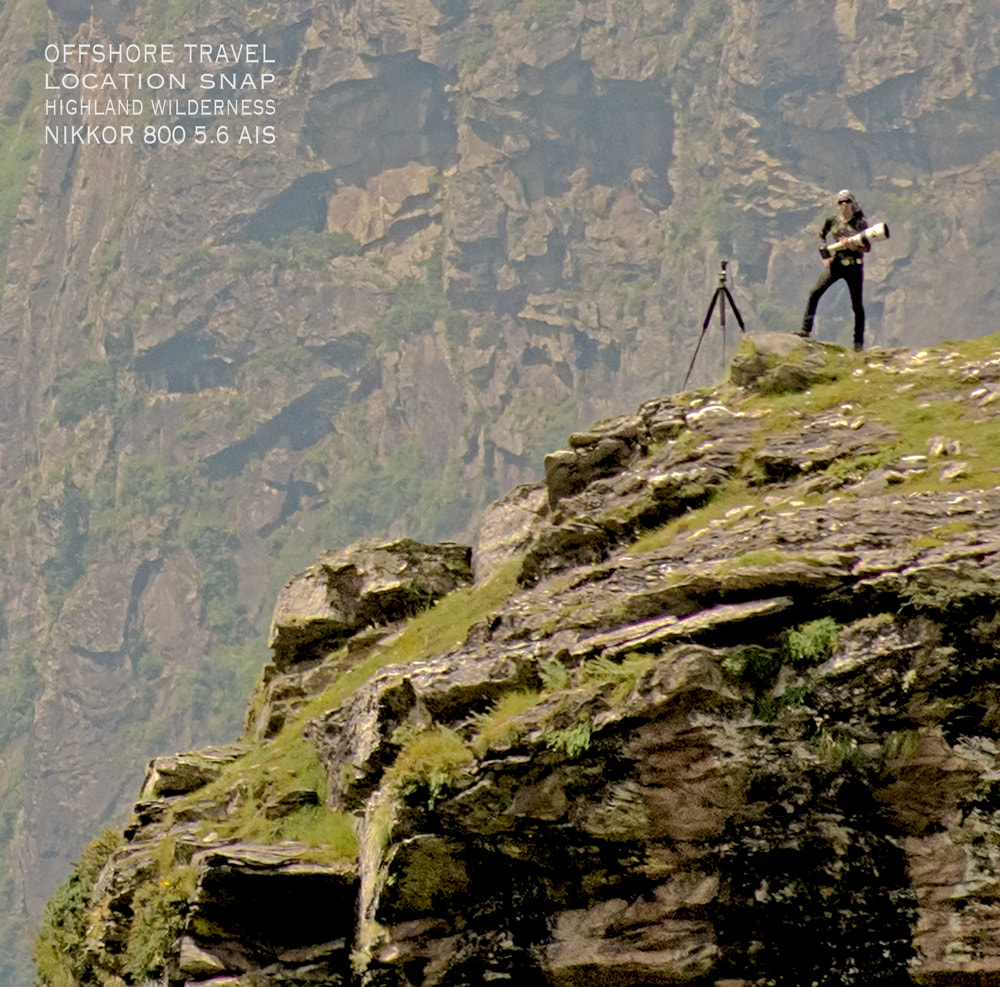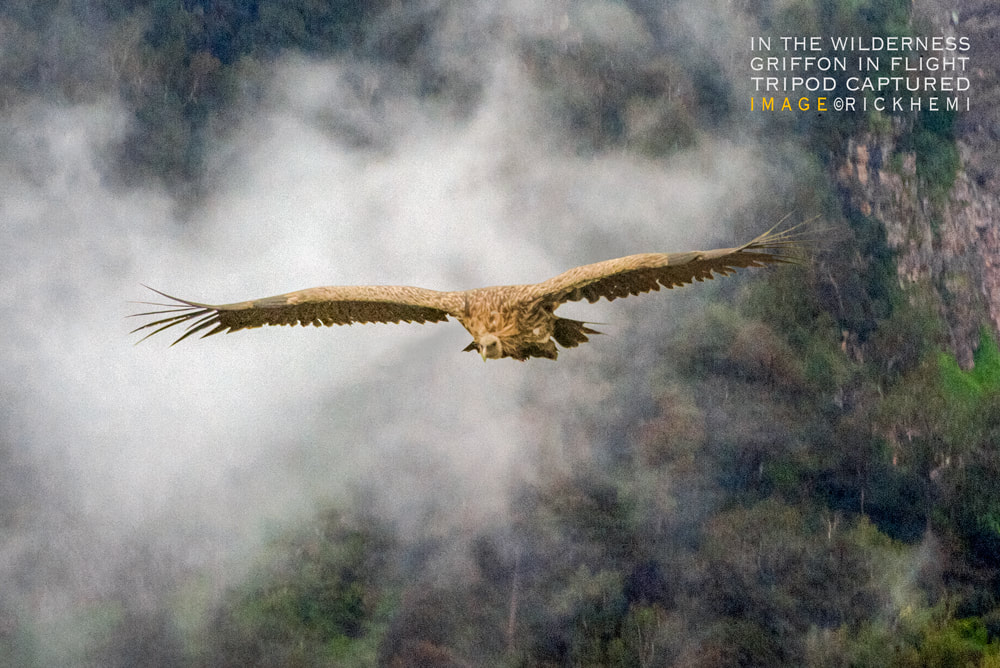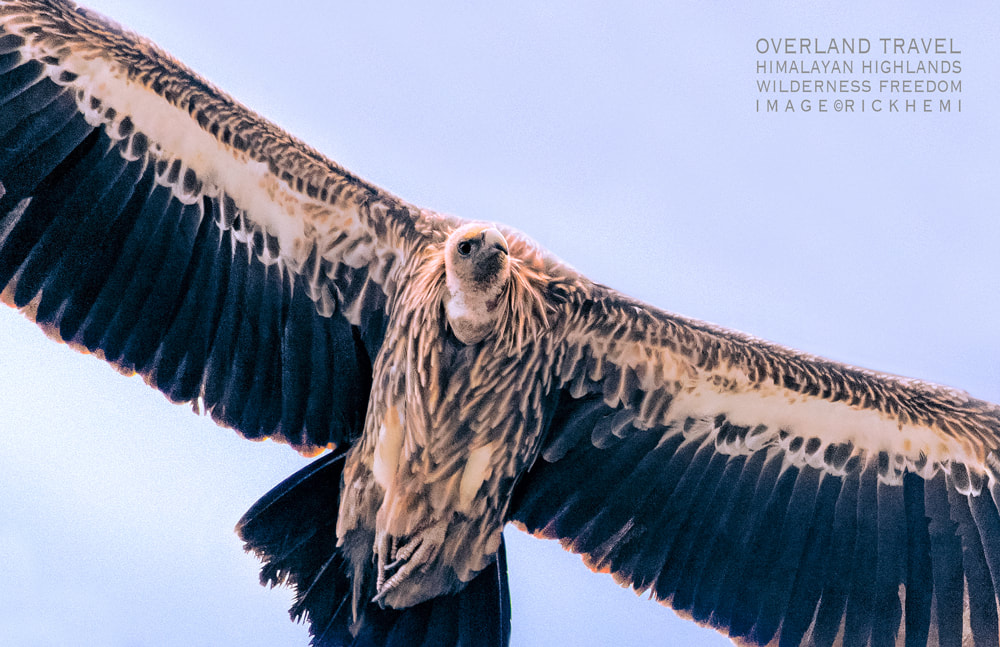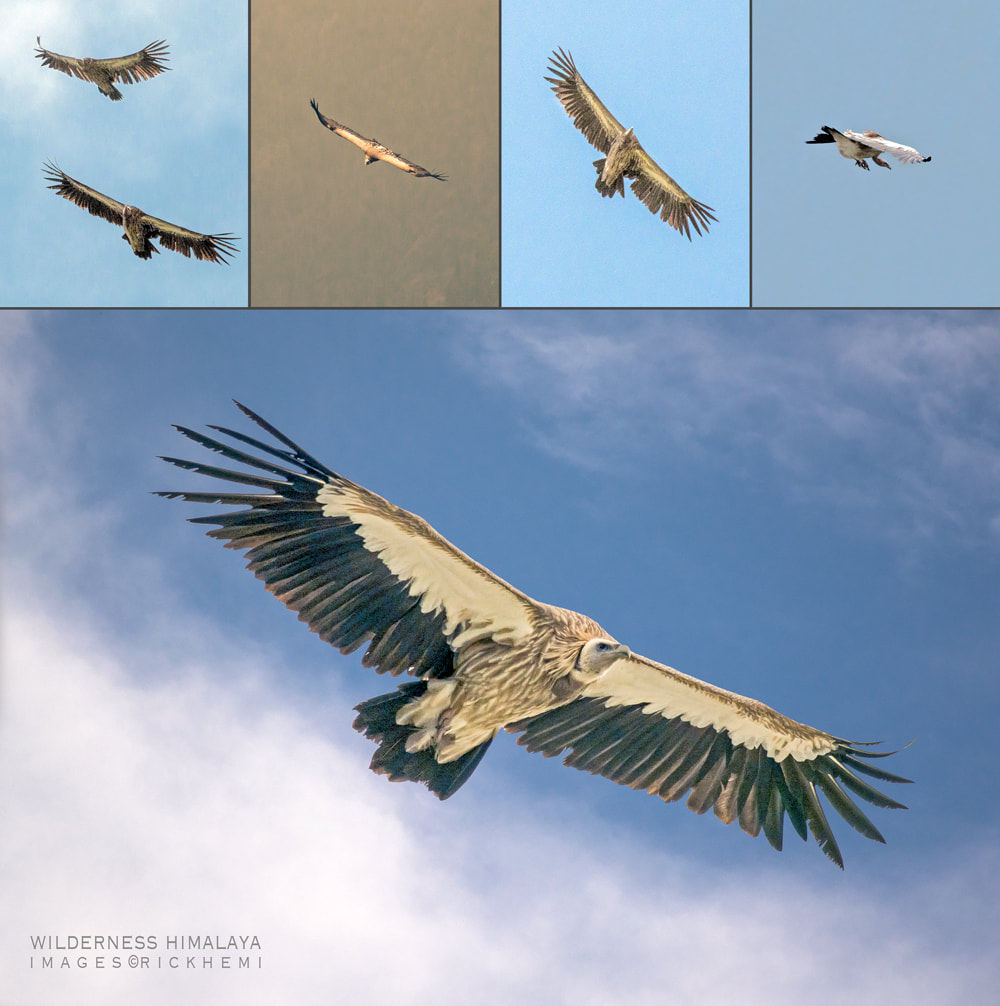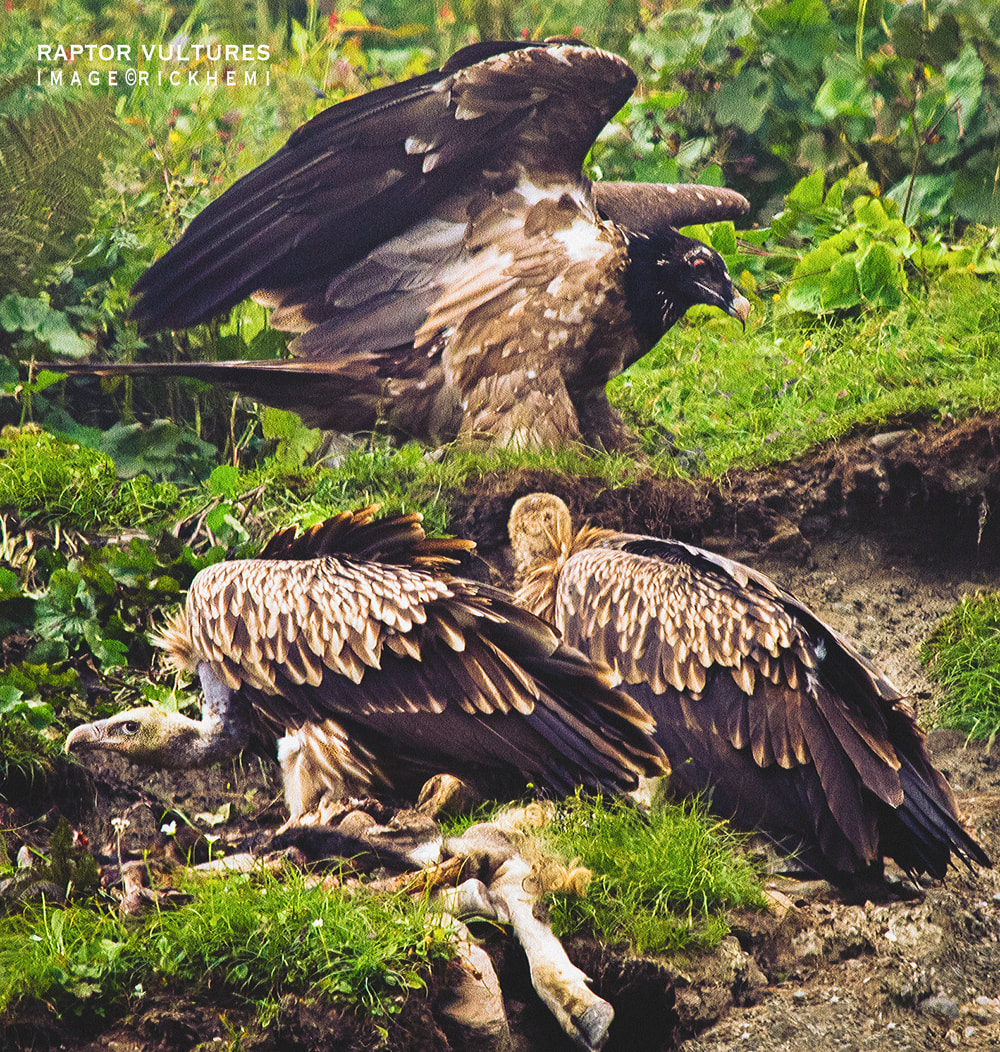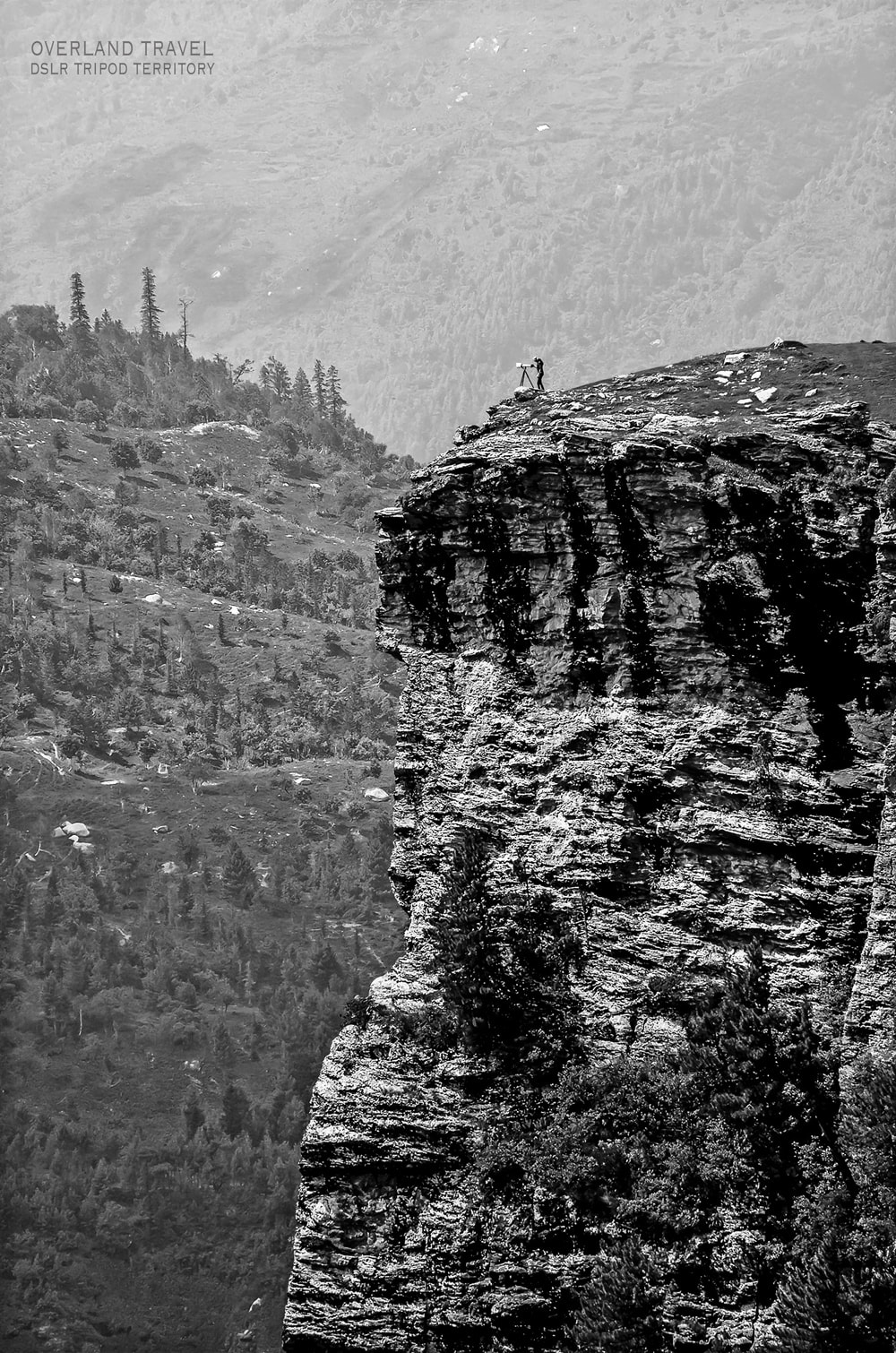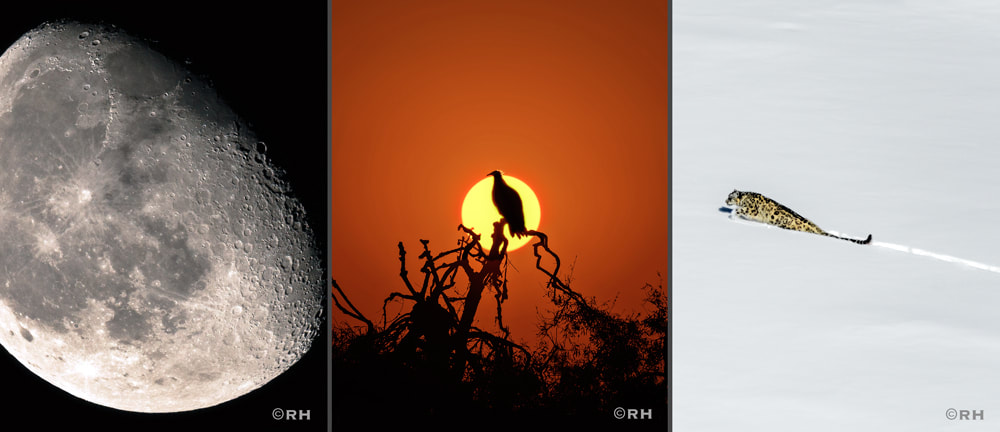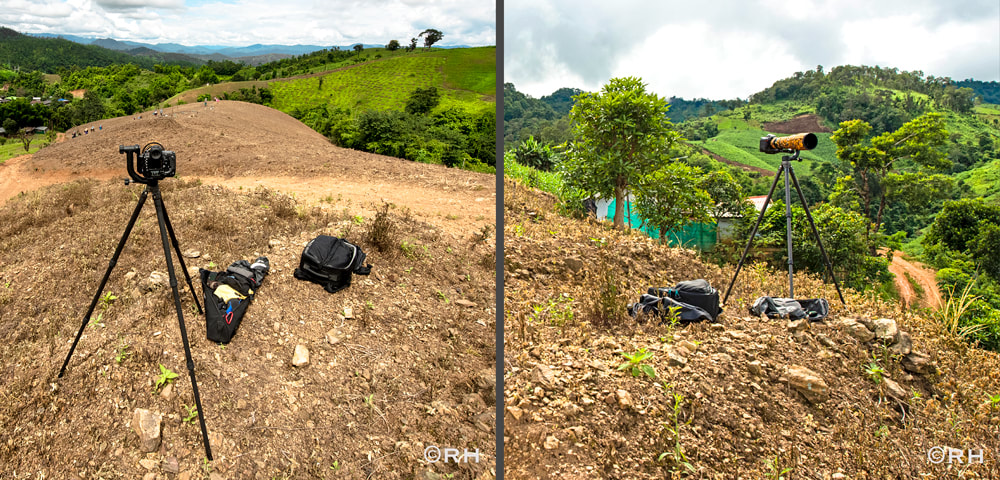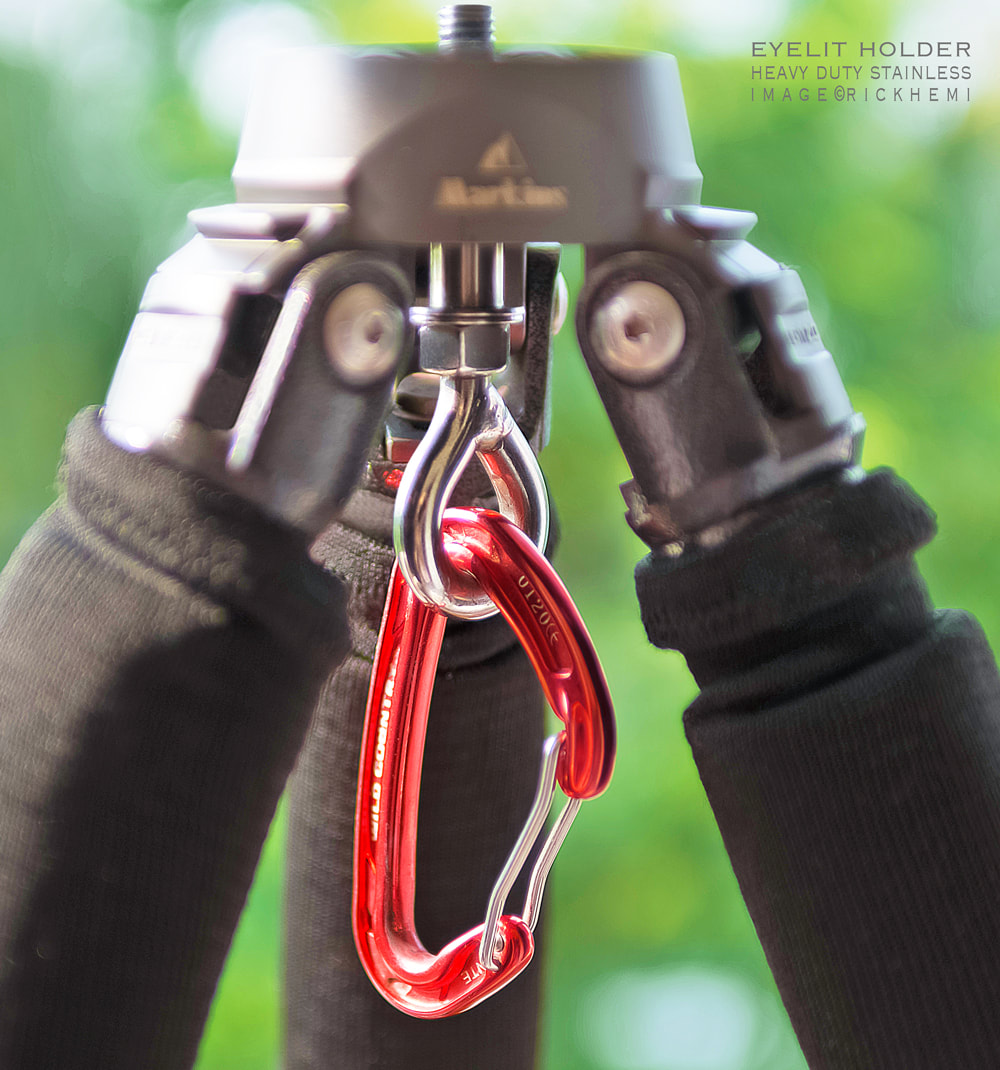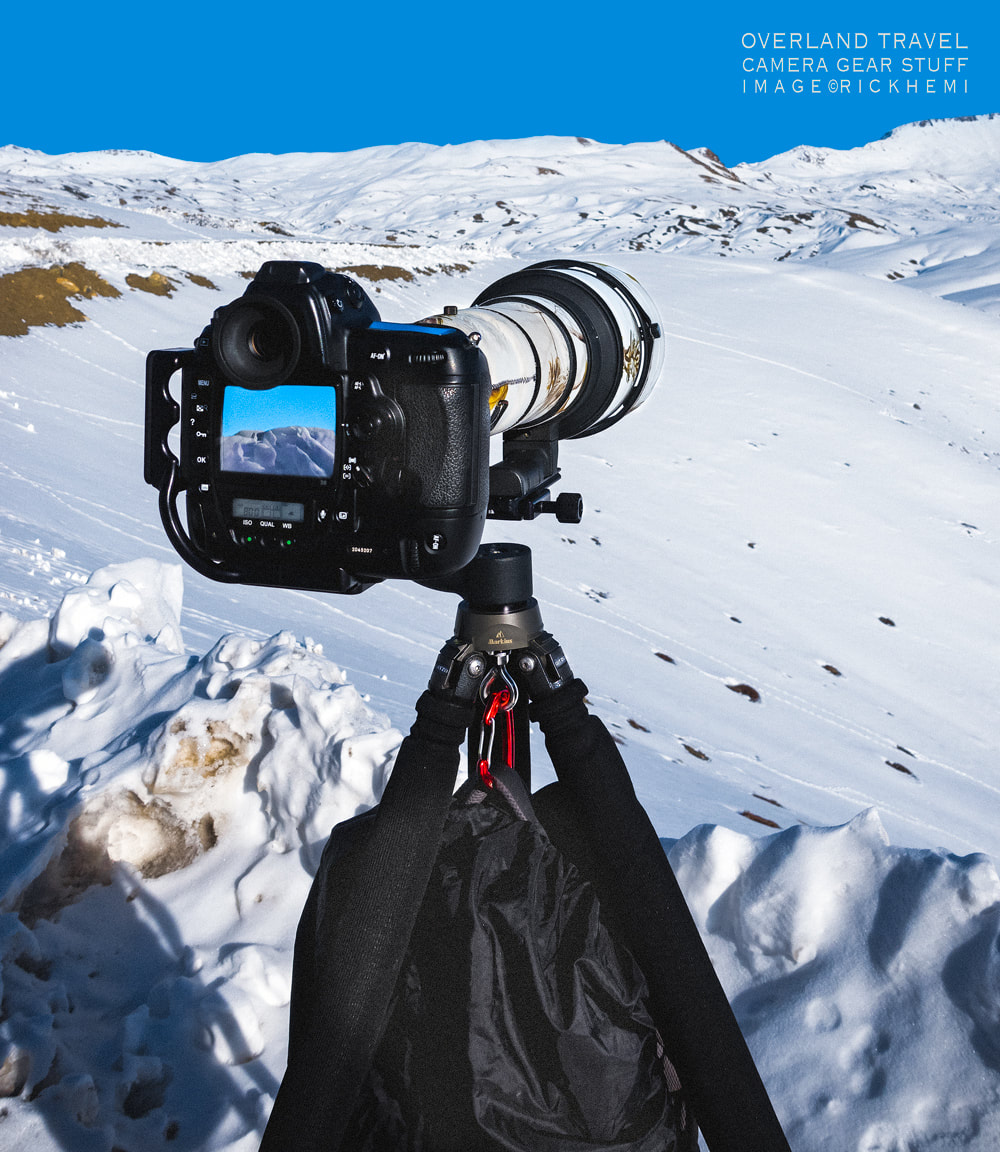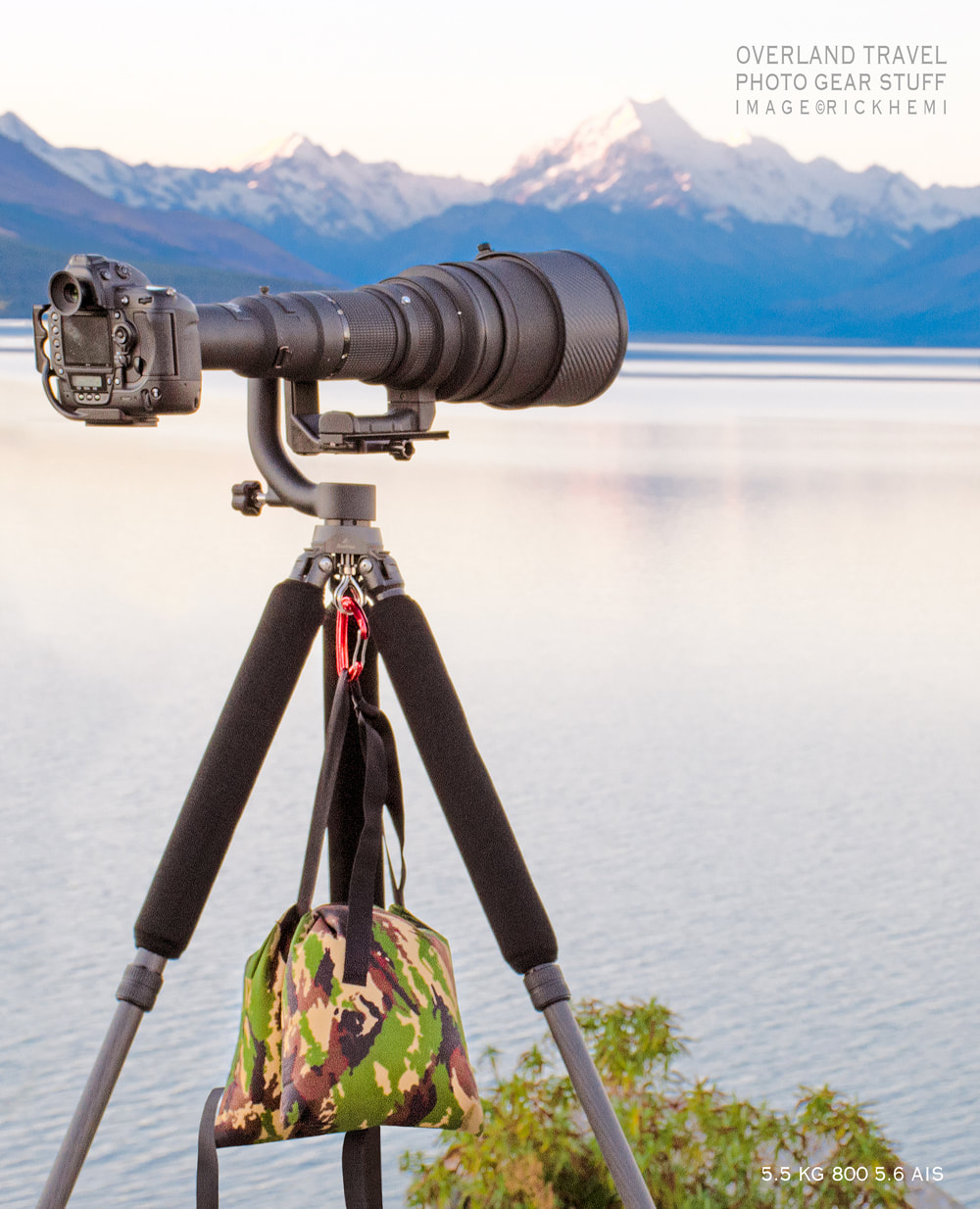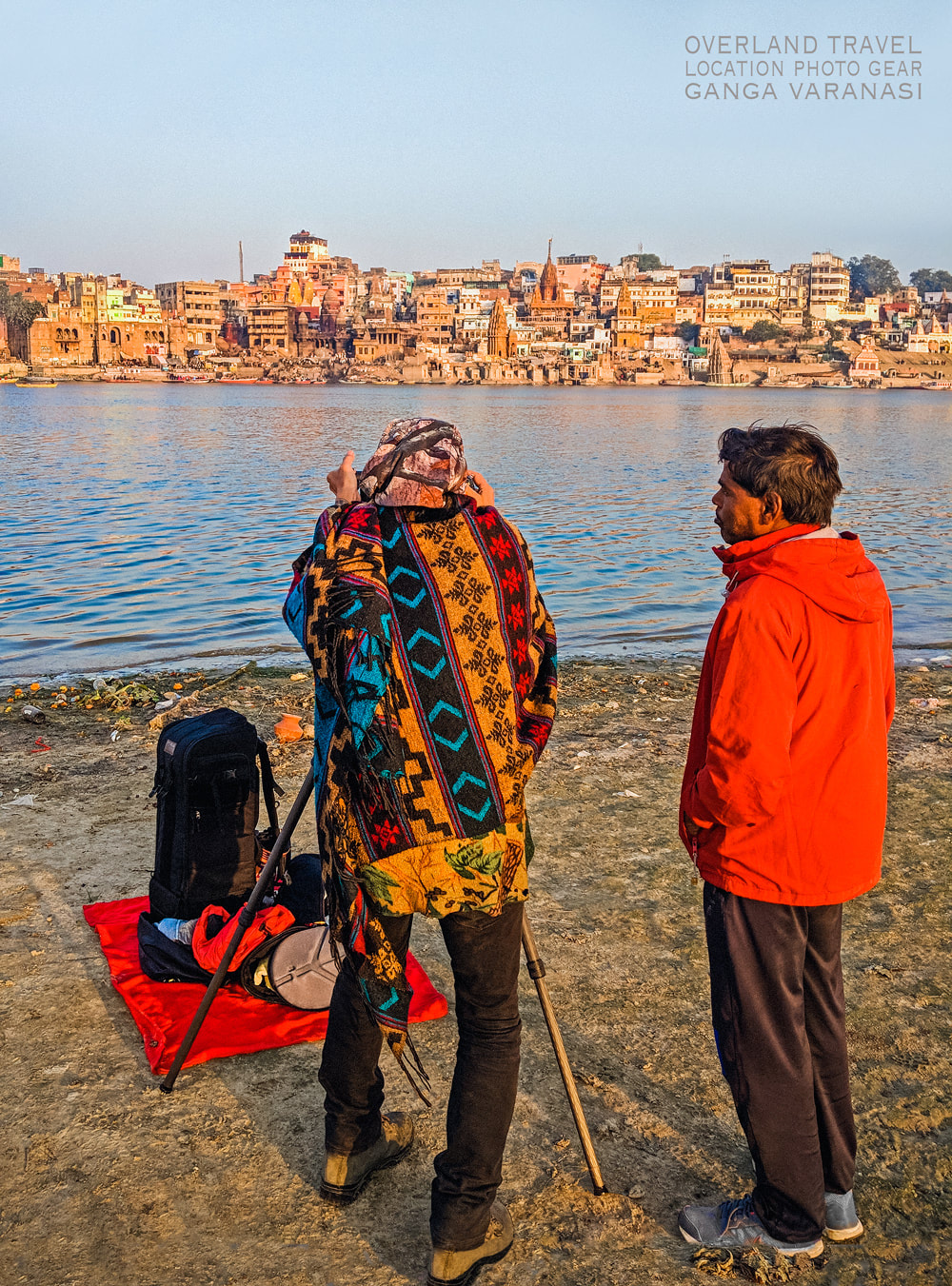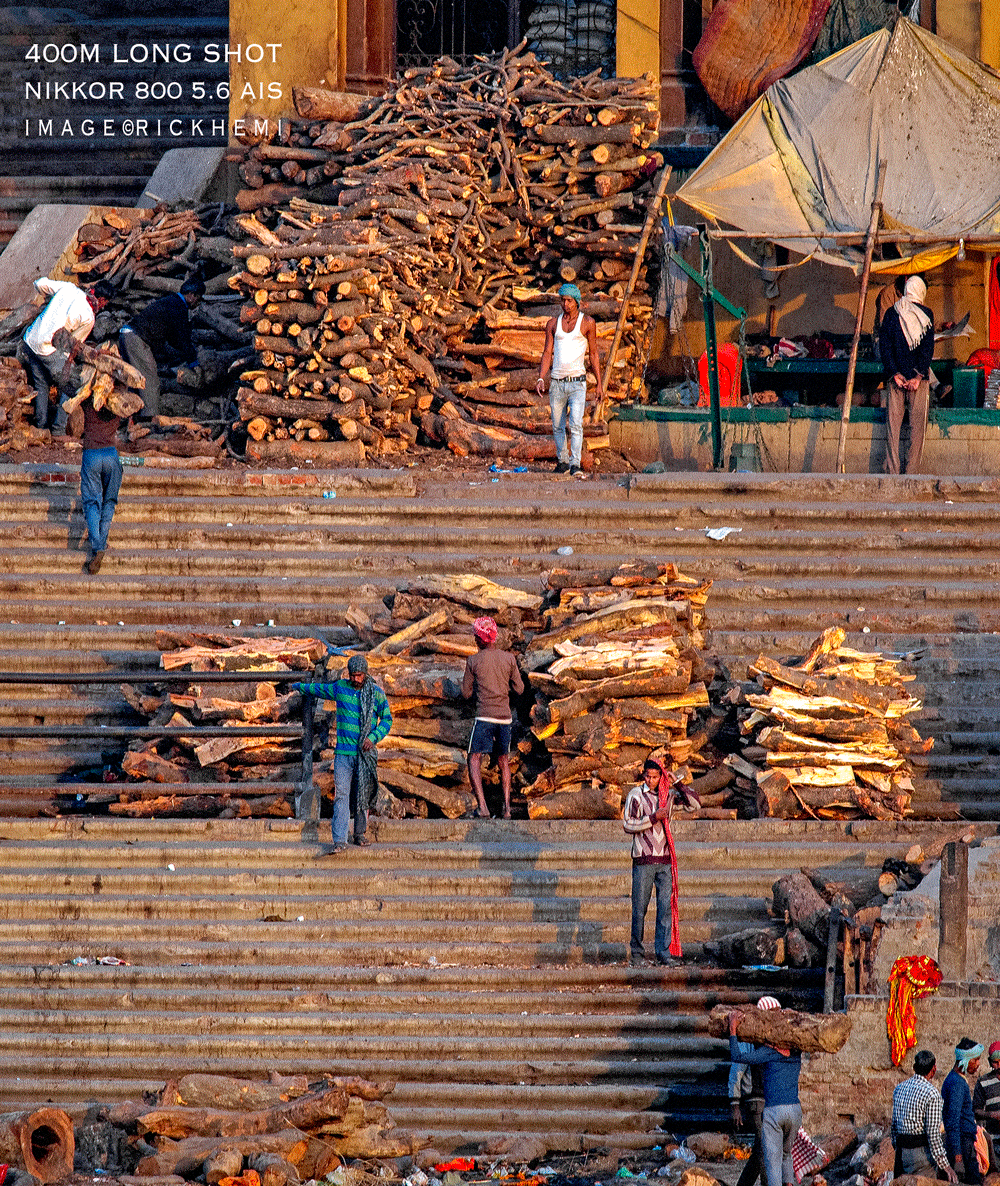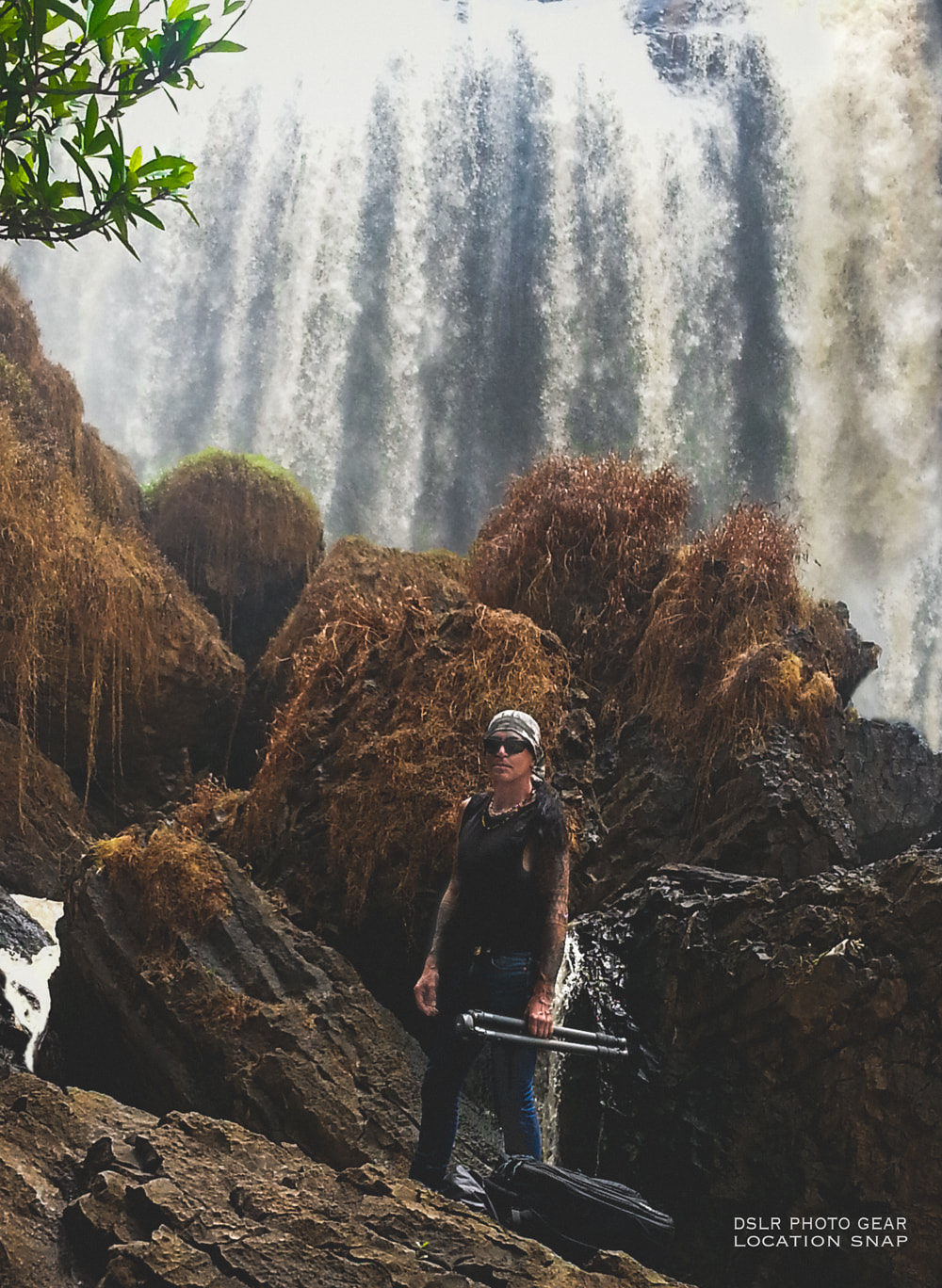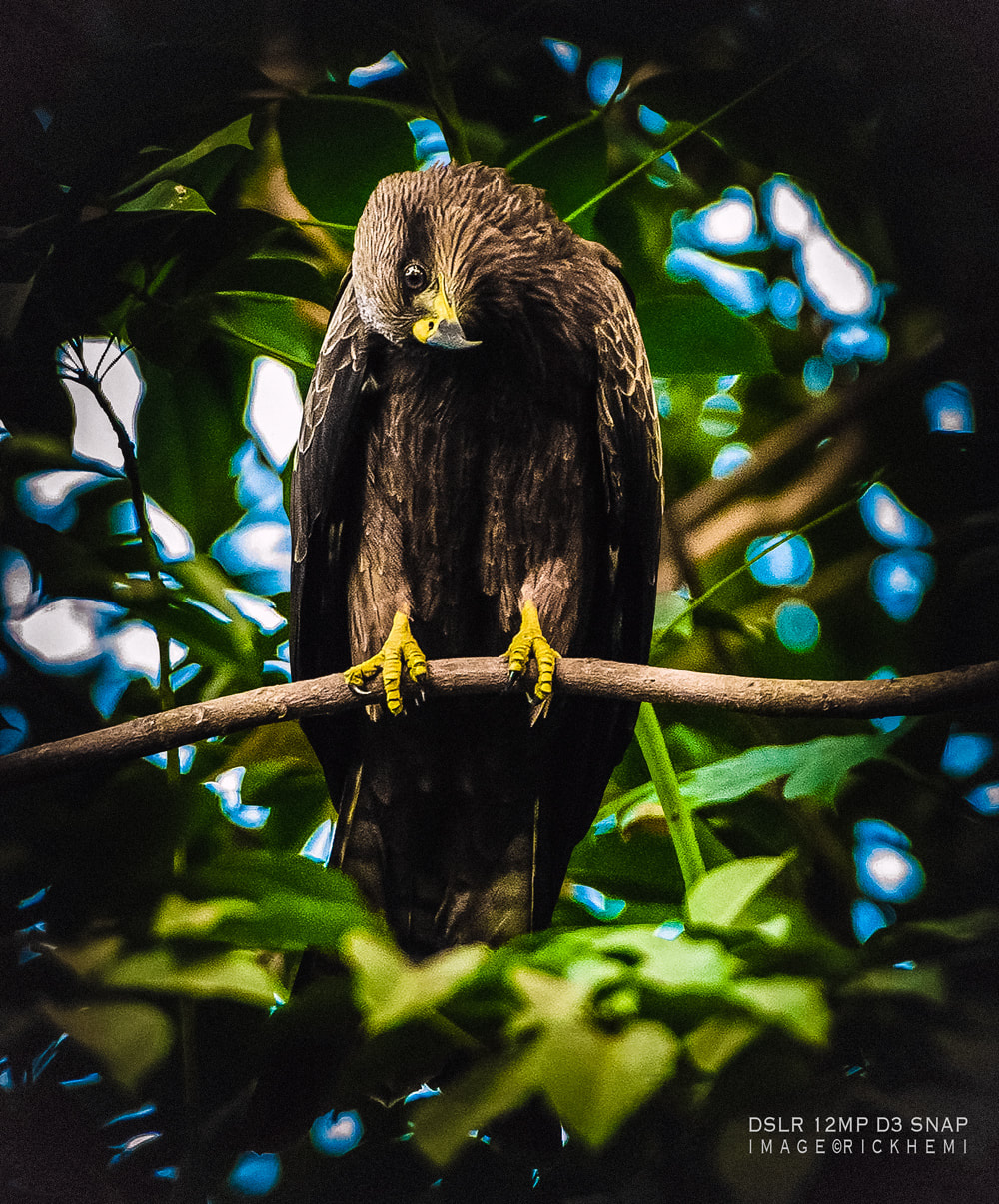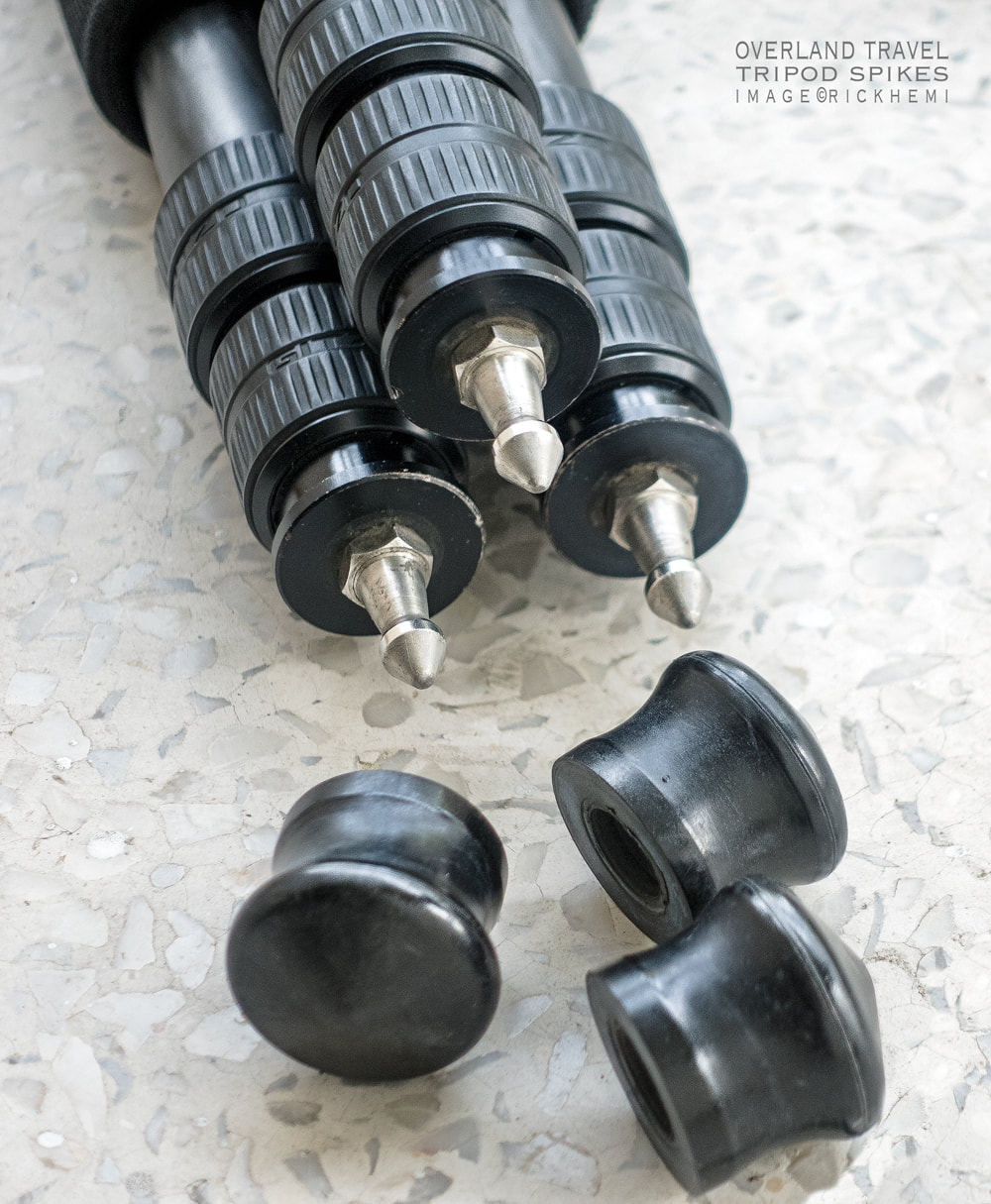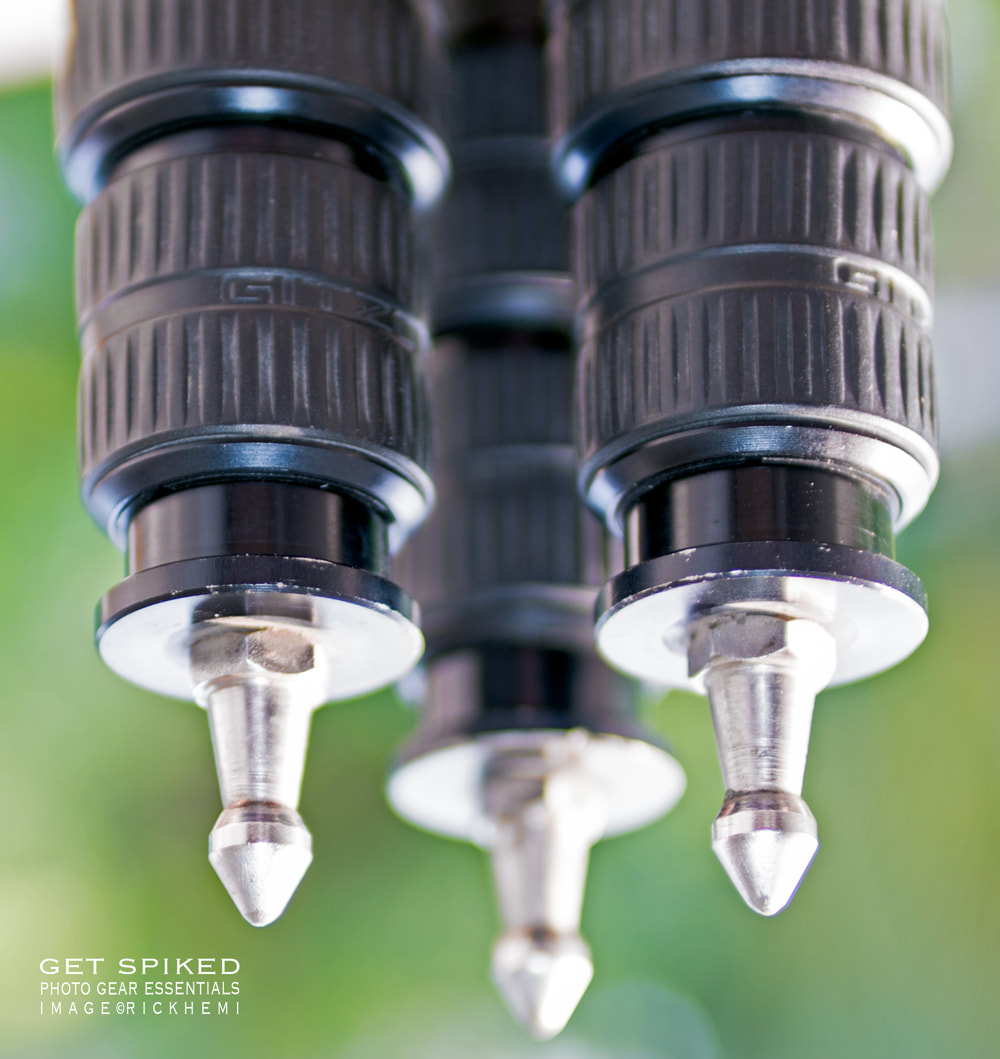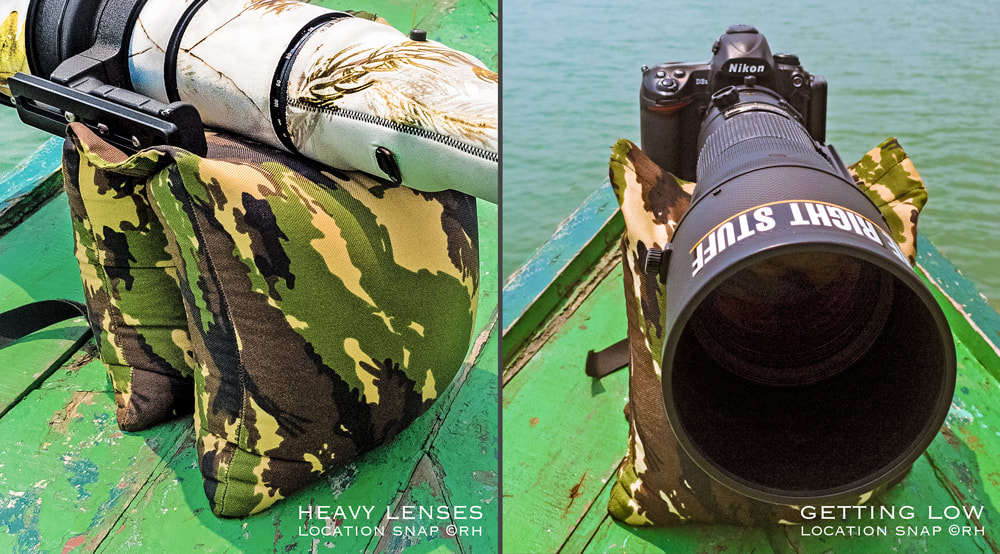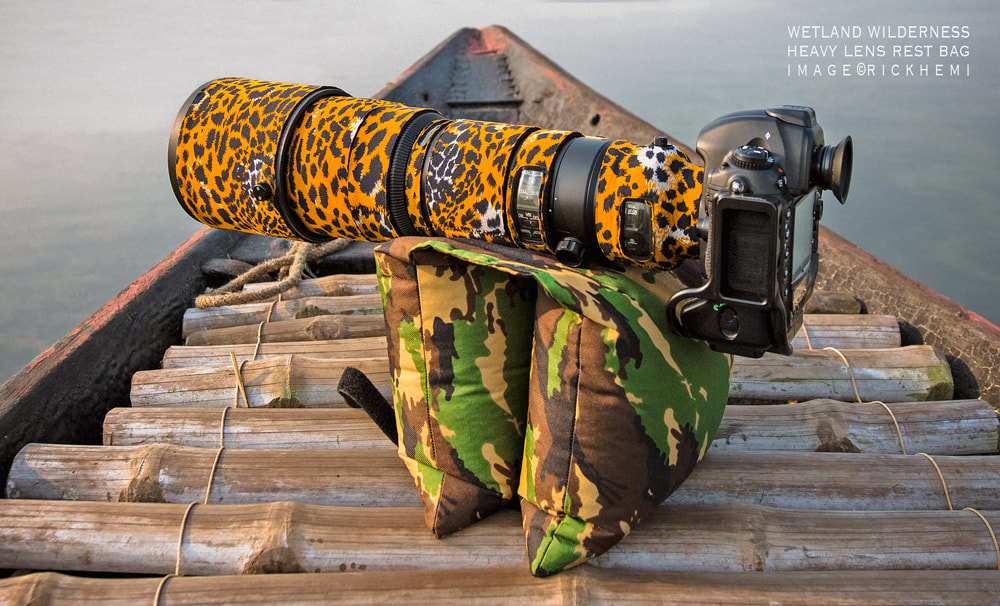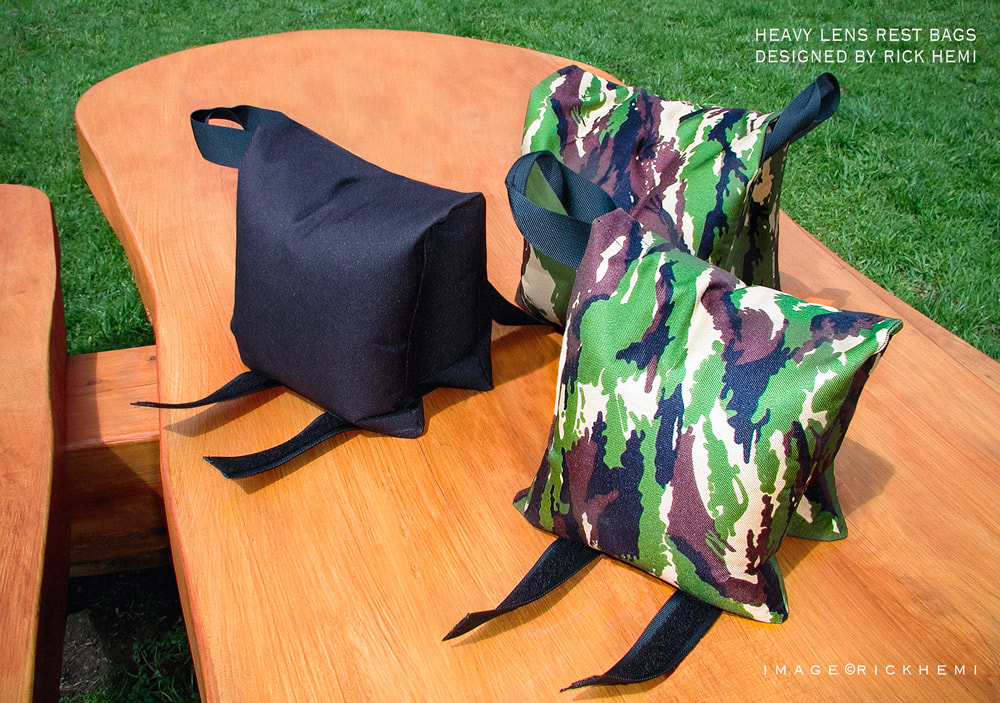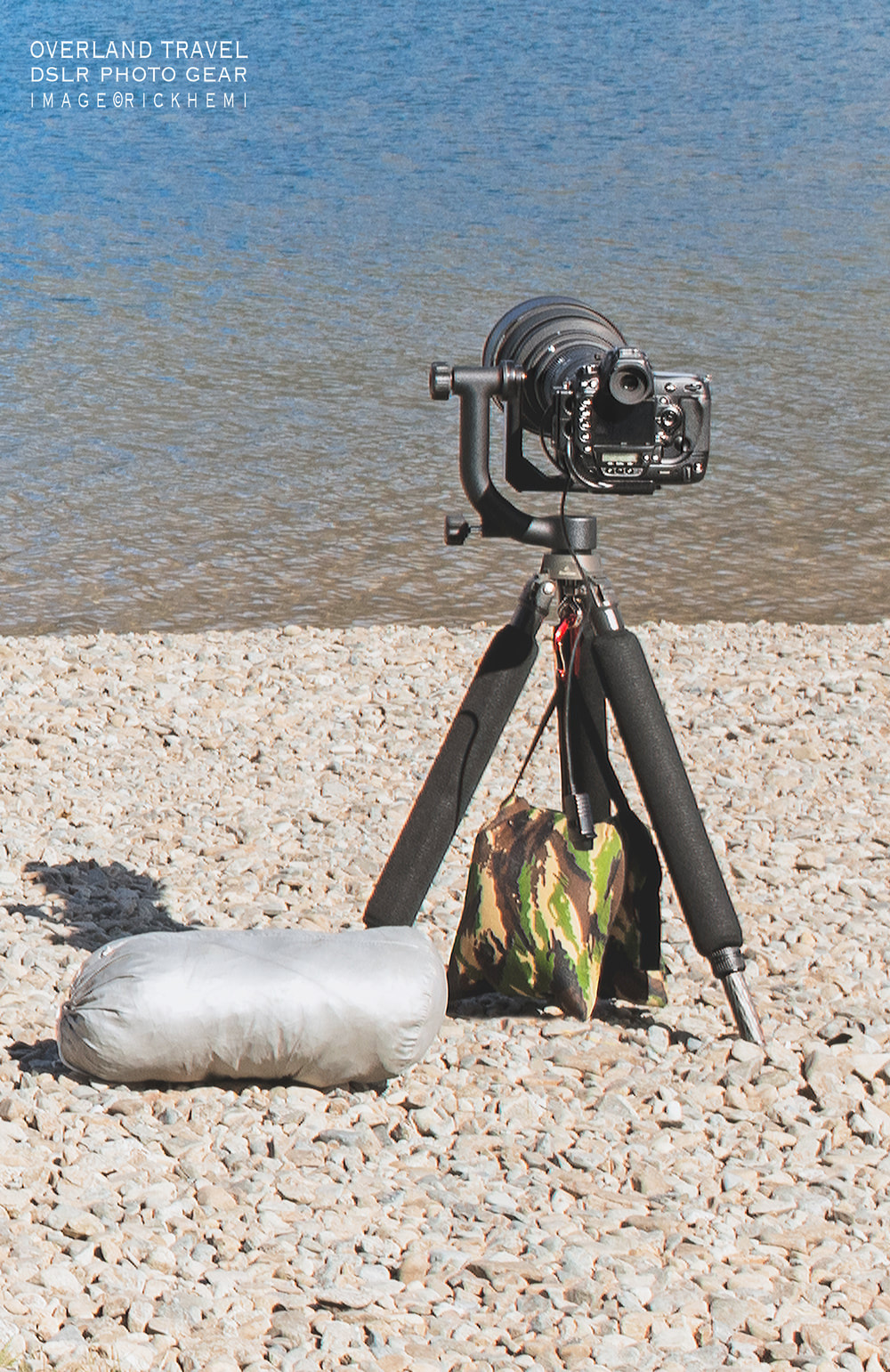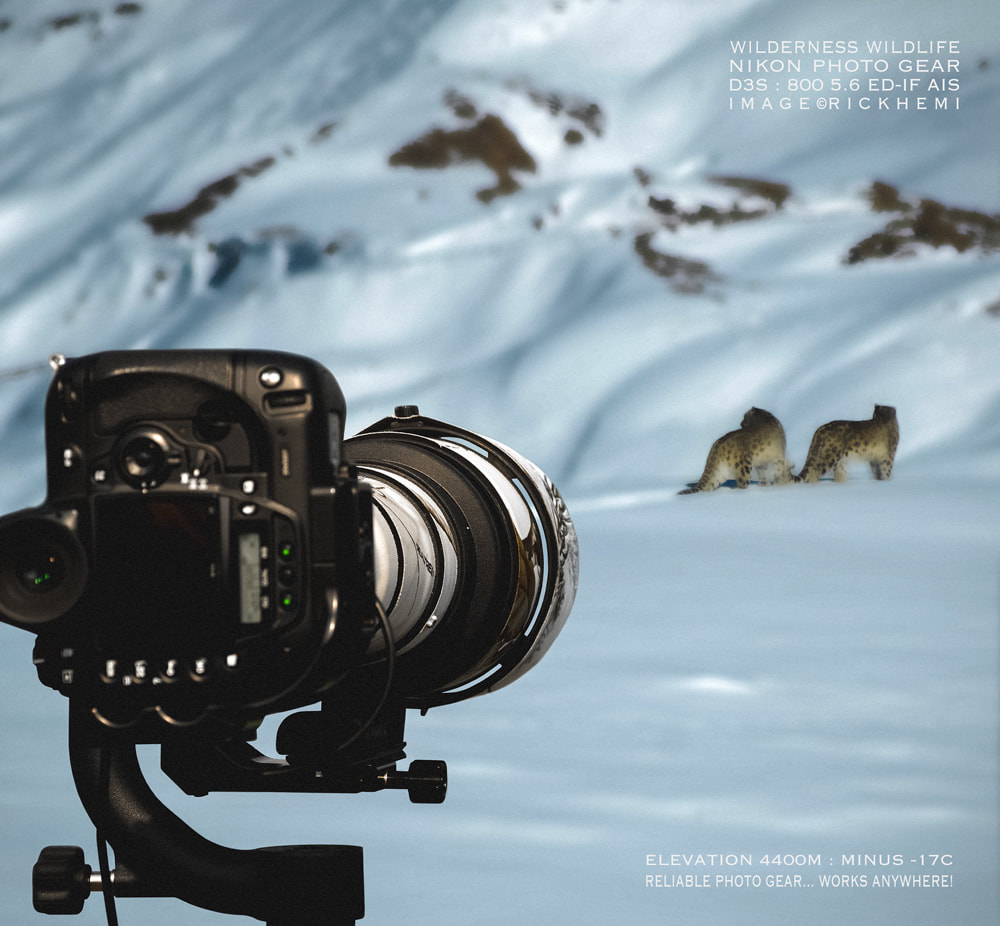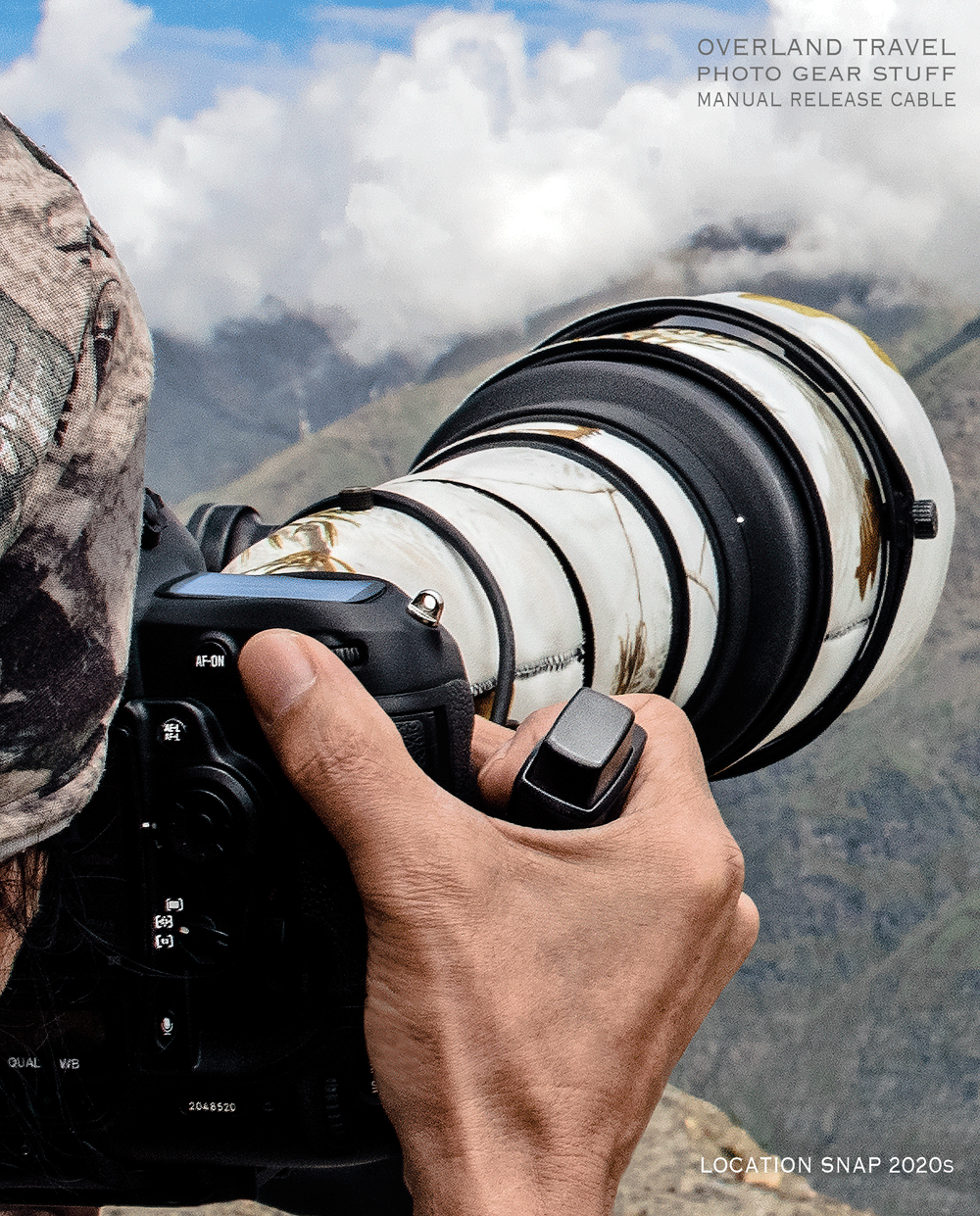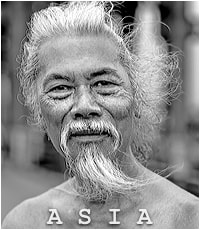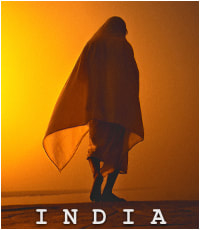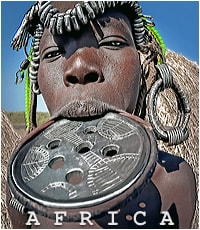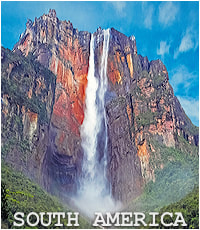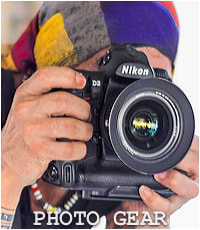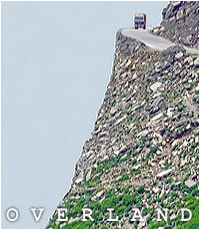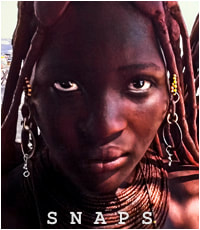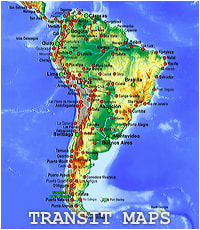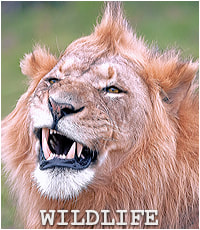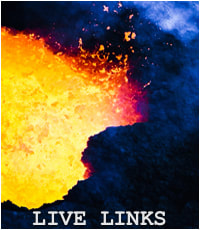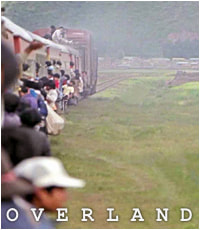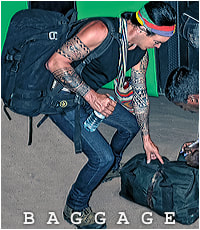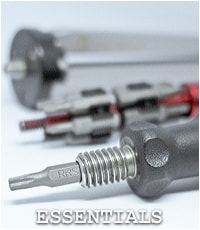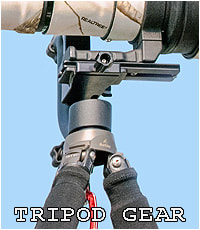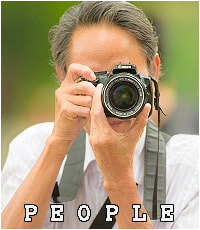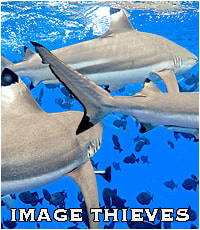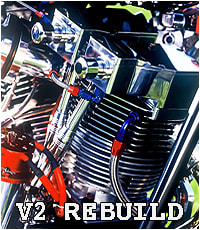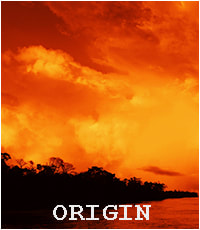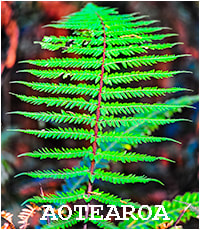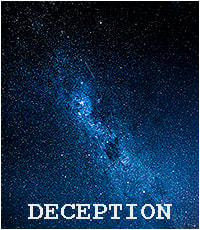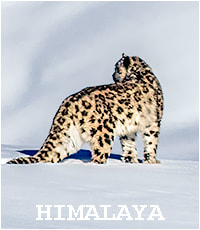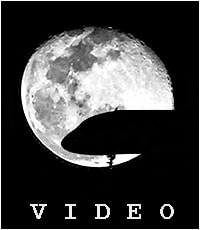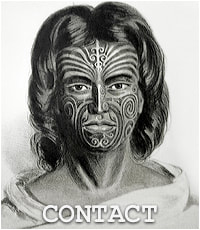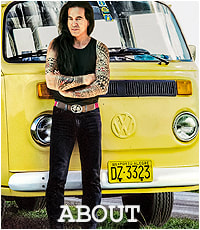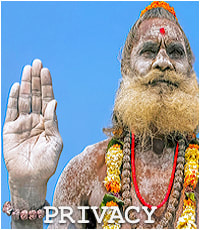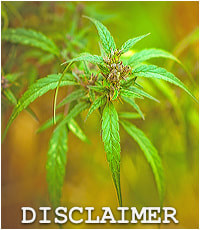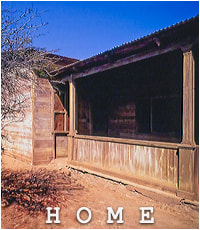Intrepid Overland Travel
Overland Travel - Camera Tripods
South America : Africa : Middle East : Asia
All Images By Rick Hemi
Above, four main tripod essentials — quality tripod head — tripod base plate — tripod spikes — stainless eyelit holding additional weight.
Wise street photographers across earth use tripods for good reason. Tripods are one of the most important photo gear items to have for outdoor photography. Captured images using tripods compared to handheld shots requires no debate. All it takes, is asking anyone using tripods confirming the above. Whether landscape, street, bird and wildlife or astro, using tripods will give far better results.
I've used Wimberley Arca replacement plates since 2009 with zero issues. Above, 6kg AFS 600 F4 ED prime with an Arca plate.
One can use whatever photo gear suiting their needs, but when it approaches outside the realm of normal street photography, tripods are normally required to capture in focus images. The following examples below, were taken with camera gear mounted to tripods. Those traveling offshore wanting images like this will have to decide if extra clothing and other baggage junk is more important than traveling with tripods. Wimberley WH-200 Arca
Above, at an isolated wilderness location capturing steppe eagles using photo gear attached to a tripod (low res reference images). Without the aid of using a tripod, the images above wouldn't exist. To alleviate disappointment, your best friend, is a tripod within wilderness regions where vehicles can't reach. The rewards of capturing in focus shots using tripods pays-off when returning to home base looking at what has been taken — every image is in focus.
Overland travel photo gear : You want to capture shots like this traveling offshore? No problem when tripods are used.
Using tripods guarantees limited camera shake using heavy photo gear — above images were captured using 6.5kg of camera gear.
Scouting around a day or two in advance looking for good locations to setup tripod gear becomes normal procedure. Setting up camera gear in rural regions is relativity straight forward compared to bustling urban city environments. Below, a simple early morning location snap with DSLR camera gear ready to go. Depending on certain locations, tripod gear is best setup as low as possible to lesson angle views. Capturing locals at this spot crossing the river was worth the time and patience.
Finding tripod setup locations the day before, best time - daybreak to 9am & late afternoons.
Below, an example image captured with an AFS Nikon 200-400 f/4G VRII lens and 12MP D3 body mounted to a tripod. Traveling offshore with tripods have their advantages. Hands free image captures are perfect, and panning the same moving subject is easy. This local was approximately taken from 70 meters in DX mode @ 600mm.
Below, the same Wimberley WH-200 tripod head used for all different types of photography since 2011. It has never failed through the continents. Rugged overland journeys sorts out very quickly what product designs can sustain long-term reliability. The Wimberley WH-200, even when holding 7 kilos of camera weight in minus -33C temps never faltered or failed. Reliability of stuff traveling overland offshore through the middle of nowhere is a priority. The images below were taken a decade a part of the same Wimberley WH-200 head.
What is reliability? A product design sustaining what it was designed for functioning year in year out with zero issues. Notice the tripod in the below image. Capturing stills at certain locations requires hand held shots and using tripods. Locals can go about their daily routine without being interrupted.
Below left, this little tough robust RRS mini pod can actually handle the weight of any DSLR body and lens. I use the RRS mini pod mainly for time-lapse captures with lightweight DSLR's, point and shoots and smartphones. This is one of the strongest well designed made mini pods out there on the market. American made by Really Right Stuff. Below right, my carbon Gitzo-Markins-Wimberley tripod combo has never let me down - not once since 2011. The tripod combo has been holding 6.5 kilograms of camera plus ten kilos of added stability weight with zero issues (Nikkor 800 5.6 AIS and pro full frame body).
The same camera tripod gear from 2011 still being used in the 2020s - that's reliability. Paying that little bit extra for reliable products, is something one should consider when traveling offshore. Cheap junk is what it is — Ready to fail when least expected within a short time.
An RRS (really right stuff) TFA-01 attached to a Sony RX100 point and shoot.
Below, a D780 and classic zoom Nikkor 80-200 AIS lens attached to an RRS TFA-01 pocket tripod. The RRS pocket pod can hold 6.8kg (15lbs) of weight. I've been using the same RRS pod since 2013 for videos and time-lapse. The newer RRS TEA-01 version can be purchased at B&H
Nothing beats design quality made to last well beyond expectations. The RRS TFA-01 CNC machined minipod has proven this time and time again whenever used. This is one product recommended for anyone looking for reliability. Early version TFA-01, newer version TEA-01.
All you need to DIY repair your own camera gear stuff during overland journeys in the middle of nowhere. Tightening loose camera body and lens screws, pull down of lenses with precision made tool bits designed and made by RRS (Really Right Stuff). The above tool bits and TFA-01 minipod are early version designs from over a decade ago, still doing what they were designed for in 2024 — Rating 10/10
I enjoy using reliable photo gear lasting for years. For some, it maybe to old, heavy and outdated. The "must have newer" of the latest released camera bodies and lenses, is an addiction. I also used to be like that. my camera gear stuff for the past decade are still doing a fine job capturing images of wildlife, street portraits and night shots. Just to prove a point, I won 1st prize in an open global photo competition with a street portrait captured with the below dinosaur Nikkor 800 5.6 AIS prime and D3 DSLR body. That's a 40+ year old lens and 2007 12MP body. My must have "new" mindset went out the door with lenses. Although the D780 is Nikon's latest full frame DSLR, which I did use, the D3/S and even the D800 capture excellent still shots using the right lenses. Below, an early version RRS TFA-01 mini pod holding 7kgs (15.4 lbs) of weight.
Above, if you can design something better, then make it - Really Right Stuff TFA-01 mini pod holding 7Kg. Off course, this image is only to show the strength of this little mini pod. The TFA-01 is used with point and shoots, and smart phone time-lapse captures.
Classic snaps with an F2AS and Nikkor 50-300 f/4.5 ED AIS. The two F2AS bodies, lenses and Manfroto 190 tripod completed overland mileage throughout South America, north and south east Asia and Europe. Center image, D700 and Nikkor 400 f/3.5 AIS mounted to a Manfrotto Wimberley head tripod combo. Top right, AFS Nikon 600 f/4 version one, the heaviest lens I've ever owned weighing in at 6kg mounted to a D700 on a carbon Manfrotto Wimberley combo. Did I have any issues with any of the above photo gear? Zero, none, nada, everything worked and functioned as it should. Although, the AFS Nikon 600 f/4 did receive a full service by Nikon in Tokyo in 2012. The lens had early signs of fungus on internal optics originating from South America.
I've been using tripods on-and-off, since the late 1980s, consecutively from 2011 onward. Although just a random street still photographer, I've learnt to accept that using tripods has helped capture all different kinds of images that would of been impossible without using tripods. Whether on the streets within big cities, in the wilderness, or grabbing night shots, without using tripods, it would of been more than disappointing and time wasting. Tripods help eradicating soft blurred semi out of focus images especially after dark. More than a quarter of the images through this website were taken using tripods. Below, the same Wimberley Markins Gitzo tripod combo still being used in the 2020s. Nothing beats reliable photo gear traveling overland offshore in the middle of nowhere.
Tripods do help eradicating soft blurred semi out of focus captures, especially after dark. More than a quarter of the images through this website have been taken using tripods. Above and below, Wimberley Markins Gitzo tripod combo being used with different camera gear. Nothing beats reliable tripod rigs lasting for years with zero issues. My own tripod combination alone is proof of that —2011-2024.
Grabbing snap captures of any moving subject using tripods gives better results with most shots 100% in focus. Solo overland travel transiting through continents is a mission in itself with the amount of baggage one has to lug around. Personally, my tripod gear are the first items packed and ready for any travel. In the past before constantly using tripods, many images taken of moving subjects were often soft or out of focus. Tripods work. Reliable tripods do what they're designed for year in year out with little to no issues.
Many don't even realize why some of their still captures are soft. It's not until using tripods when the majority of stills taken improve.
Camo clothing, leopard lens coat camouflage, image by Brain de Riancho. Are lens coats worth their value? Let's just say this Nikon AFS 200-400 f/4G VRII lens still looks as new, since first purchasing the lens in 2011. Not all lenses require lens coat protection, but those who want to keep their photo gear scratch free use them.
Above, tripod setup capturing snaps with plenty of free space. Below, an hour later at the same location.
Locations overflowing with tourists can be the worst nightmare for tripod users. Two week tourists lack balance of harmony between other two week tourists and fellow travelers. The above location, a well known destination has an endless stream of people passing through it yearly. Even though arriving early finding a good place to set up, automatically creates a magnet for others to also crowd at the same spot. Two week tourists assume anyone using tripods and camera gear have picked the best location capturing images. On most occasions people do keep their space, although rude obnoxious lowlifes can't help themselves disturbing the peace. Best advice, get to busy touristy locations early, capture all necessary images and move on.
An additional Wimberley perpendicular M-8 plate is required when attaching cameras directly on WH-200 Gimbal heads. Camera bodies also require arca L brackets, like an RRS or Kirk. Location snaps of the Wimberley WH-200 head P-5 plate combo.
Gitzo Markins Wimberley - Combo Tripod Gear
Gitzo Series 3 & 4 Replacement Hubs - Markins Lightweight TH-300
If you're like me, and want tack sharp images 99% of the time, a reliable robust light weight tripod and tripod head is recommended. There's always a spot to set up tripods in the middle of bustling cities, or inside vegetable markets, and bazaars. As they saying goes - location is everything. Capturing distant wildlife without using tripods is difficult. Walking around through any wildlife sanctuary carrying the weight of a 2-3 kg lens and body all day becomes slave labor. In general, most wildlife subjects will remain at certain locations if there's ample food and water. Using tripods will not only ensure tack sharp image captures, but save the arm muscles to last through a full days shoot.
I bought the above Gitzo series 3 CF GT3531 online second hand for under half the new retail price. Even though the tripod was advertised as in new mint condition, I asked if it had been used on beaches. Sand granules have a habit of slowly grinding everything to bits if not removed. On the first day of receiving the tripod, it was striped down and pulled apart.
The sealing rings and cone collets had plenty of traces of beach sand. A soapy wash using a toothbrush and compressed air removed the granules. A closer inspection showed zero damage to moving parts. Buying second stuff has its risks, especially when some sellers lie about the product they're selling. The center extension stem and original hub was replaced with a super strong lightweight Markins hub. This made the tripod the perfect combo fit with the Wimberley WH-200 head. It was also smaller and lighter for offshore travel. This tripod setup is still being used IN THE 2020S. Rating 10/10
Below, street still image captures of a moving subject with each image capture in focus and level using a tripod.
Still Photography - Tripod Assisted
Looking for street locations within busy bustling areas can be at times challenging. The rewards are satisfying, if there's enough place and space. Finding early morning rush hour traffic in central Hanoi ended up at Bien bridge. On one of many walks through the city, I found the bridge off-ramp a good location for moped traffic.
Early morning location snap using DSLR photo gear capturing stills and video of rush hour moped traffic.
Panning - Tripod DSLR Gear
Even my old reliable 2007 D3 daylight workhorse, normally used for street photography captures birds in flight when attached to tripods. The only issue with D3 bodies capturing moving shots, is the limited buffer. Attaching quality lenses on the D3 can produce good images. The below examples are heavily cropped enlargements from original NEF files.
Tripod Heads - Choose Wisely
There's a saying "keep on walking and don't look back", that's exactly what happened when I switched over to a WH-200 Wimberley Gimbal tripod head. Although there are some great designed ball socket tripod heads, the Wimberley Gimbal WH-200 works consecutively for everything I personally use it for. You name it, street photography, landscape, night shots, festivals, wildlife, astro, diverse etc. The below snaps show some of the original tripod head stuff I used to use - now a faded memory.
I used to travel using quick release ball socket tripod heads - Not any more.
Gimbal Heads & Arca Plates - Wimberley
Wimberley arca P-5 and C-12 plates for different combo setups. Below, a recent snap of the WH-200 Wimberley Gimbal tripod head offshore. This is the same WH-200 head I've been using for more than a decade with zero issues. I use the WH-200 for all my photo gear when required. This is one of the first items, including my tripod that gets first priority heading out the door.
Using clone copies of any product design, is at your own risk. When stuff breaks, it's guaranteed to bust when in use. Good quality made tripod heads will last for years without giving issues. Just to save a few bucks can result in damage to camera gear when on location in the middle of nowhere. Avoid cheap Chinese copies — of anything! They have less or very little tolerance tests when made. Forget about glossy advertising promoting products. Instead, look at what the product is made of, not the fancy packaging it comes wrapped in. At the end of the day, it's your camera equipment that's at risk. American, Australian, Japanese, South Korean and European made stuff can be trusted. Here's quick examples of American made knives and swords getting torture testing, Dawson Knives USA — Knife check : sword check
Not all gimbal tripod heads share the same quality design status. Quality made designs are recognized by years of flawless service.
The difference of quality of any product design, is not by glossy promotional advertising, or the fancy boxes they come in. Design & build quality is tested by years of continuous usage. Gimbal tripod heads come in various shapes and sizes. Higher end gimbal heads come with zero design flaws. They just work year in year out holding 7+ kilos of weight used at any angle. El cheapo gimbal heads do have trouble holding the same weight. Having heavy expensive camera gear mounted on flimsy constructed gimbal heads, is at your own risk. The risk factor become more dangerous when using wing bling gimbal head designs after dark.
What to look for with El cheapo designed gimbal heads — small adjusting knobs, wobbly lower main shaft when loose, top adjusting support bracket requires two hand movement tilting lenses, over-tightening adjusting knobs to keep lenses at chosen positions.
What keeps random still photography addictive offshore? Firstly, not knowing who will become your next street portrait, capturing bustling urban and rural landscape, dusk sunsets, lunar and roaming wildlife. Second, one has to have positive enthusiasm, inspiration to do all kinds of different street photography. Those having little or no interest already know they don't require anything past their smartphones. The amazing thing about street photography, especially when traveling offshore, is that each day, every week and month, is different to the next. Capturing stills isn't at all boring. One only requires reliable camera gear with enough optical range to get desired results. Most will notice numerous images through this website of the same camera gear being used at different locations.
Some of my lenses have been used since 2009, and believe it or not, are still being used offshore in the 2020s. There's nothings better than knowing what your own camera gear is capable of capturing. I don't follow trends, actually I avoid them. I don't need the latest lightweight 500 MP mirrorless to capture good images. They may give more resolution, more user friendly controls, but for now some of my older stuff are still capturing great images. If you already have proven reliable camera gear, add to it instead of replacing it. Below, Wimberley P-5 body plate attached to an M-8 plate on a WH-200 gimbal head.
Overland Travel - Combo Tripod Gear
Quick example shots capturing birds in action in the wilderness using camera gear mounted to tripods. The addition of using tripods guarantees more positive results than hand-holding camera gear. Those heading offshore into all types of photography using heavy full frame DSLR photo gear, should consider traveling with a quality tripod and tripod head. One will find quickly how valuable tripods are, and will never leave home base without one again.
Stop motion still captures with heavy photo gear mounted to the same reliable tripod and gimbal head I've been using for 12+ years.
Wetland birds captured using a tripod. Setting up at different locations with tripod gear isn't a burden — It's a positive necessity.
Most think having the latest camera gear is the uttermost priority traveling offshore — wrong. It won't make you a better still photographer. What will help, is any reliable robust tripod lessening vibration. Best advice — Don't leave home base without one!
Personally, the most important photographic item of all, is a tripod. To verify, just ask any landscape or wildlife photographer. They don't rely on lens vibration reduction. You'll be hard pressed finding professional photographers presentations of misfires and out of focus soft shots, even though they have plenty of them hidden from the light of day. Seasoned amateur and professional still photographers alike use tripods for good reason.
Example stop motion stills within isolated wetlands using camera gear mounted on a tripod — DSLR, AIS prime images by RH.
Timing plays a roll at any location with camera gear. One can return to the same place with different outcomes. Never think the same ambience will always be there waiting for you. A random street snap captured with a Nikon DSLR D3 mounted to a tripod.
I never replace or update camera gear unless it falters, or self-destructs beyond repair. The Gitzo Markins Wimberley tripod combo has given 100% reliability since 2011. It has been used and tested in numerous extreme regions below minus -30C to +50C with zero issues.
Above snap, captured from distance for obvious reasons. If bitten by swamp jackals, a rabies shot will be necessary — DSLR/Tripod.
In the wilderness, the aid of using tripods capturing distant birds and wildlife is automatic. Time spent at most isolated locations require cameras mounted to tripods. Above, a pair of Griffon vultures perched on tree tops captured from long distance, in DX mode, 2007 D3 and 800 5.6 ED AIS manual focus lens. This shot wouldn't exist if a tripod wasn't used — It's simple as that.
Above, long shot across mudflats using full frame DSLR photo gear mounted on a tripod at a distance of 600+ meters. Below, 2007 Nikon D3 and 38+ year old AIS prime lens produced this 6MP image in 2024 — on a tripod. How about that? Dinosaur photo gear still working perfectly for still photography (f/11 1/60 sec ISO 141 DX format).
Have you ever tried capturing multiple lunar stills without using tripods? Avoid disappointment — travel with a tripod!
There's good reason why people hold on to their D3 & D3S bodies for still photography in the 2020s.
Below, photographing closeups of eagles in the wilderness depends on location and terrain. Steppe eagles are migrant raptors spotted throughout central and south Asia, Middle East, north and east Africa, and regions in Europe. They group together during migration in September, October, and again in March, April. Their flight mileage can total 8.000 to 11.000 kilometers. Steppe eagles are found in wetlands, marsh, and lowland bush. Below, Mongolian Steppe eagle, image Nikkor 800 5.6 AIS, D3 12MP, Wimberley, Markins, Gitzo tripod.
Overland Travel - Reliable Tripod Gear
Two other excellent tripod brands out there are Benro and Really Right Stuff. You get what you pay for, so it's best avoiding cheap wing bling made junk if you value your photo gear. My own combo tripod rig has been working fine holding seven plus kilos of camera weight, including ten kilos of added weight support. I also pull down dissembling individual parts servicing everything at least once a year as a precautionary measure. Inspecting tripods and heads for hairline fatigue cracks is a must do when using heavy photo gear. It's guaranteed tripods will fail unexpectedly when camera gear are mounted on them. Gitzo series one failure : Tripod mounting screw issue : RRS truth bomb about tripods
Through the decades I've met many other street photographers who travel without tripods. The tripod for them is the most ignored item when it comes to offshore travel photo gear. They will use the normal excuses like "tripods are to cumbersome to carry around", or "my camera can capture anything without the need of tripods". I also used to think like that, ignorant to the fact that tripods are as important to the cameras themselves. It's like going deep sea fishing without using bait, or using a machine gun without ammo.
Take some good advice — traveling offshore with tripods isn't that difficult. Yes, some tripod models are bulkier than others, and require reliable protected tripod bags for knocks and drops. Setting up tripods at different locations becomes a priority. All I can say to others out there, the Gitzo GT3531, Markins replacement hub, Wimberley WH-200 tripod head, and Manfrotto MBAG-80P was the best investment I've made with photo gear.
These still snaps wouldn't exist without using a tripod. Best advice — travel with one on your next overland journey!
Without the use of tripods lunar and astro shoots are almost impossible to capture.
Wimberley USA replacement foot plates has you covered for most Nikon, Canon and Sigma lenses.
Take some good advice, traveling offshore with tripods isn't that difficult. Yes, some tripod models are bulkier than others, and require reliable protected tripod bags for knocks and drops. Setting up tripods at different locations becomes a priority. All I can say to others out there, the Gitzo GT3531, Markins replacement hub, Wimberley WH-200 tripod head, and Manfrotto MBAG-80P was the best investment I've made with photo gear.
Anyone using Wimberley WH-200 Gimbal heads will likely agree this is one of best top quality tripod head designs on the market, especially for heavy lenses. Personally, I would never go back to using ball head designed tripods. The WH-200 gets 10/10 ratings for easy assembly, lens mounting, functionality, quality and reliability.
When selling off lenses, I normally keep the Wimberley multi-fit arca lens plates for other lenses. It saves time and the hassle of reordering the same plates once again. Above, a selection of backup arca plates used on past lenses.
There are Wimberley replacement lens foot plates for almost any make and model lens. Below, a Wimberley P50 adapter plate is required for the Nikkor 800 5.6 AIS MF lens. The 5.5 Kg 800 5.6 has used the P50 plate since 2016 with no issues.
Manfrotto MBAG-80P - Tough Tripod Bag
An MBAG-80P used since 2010 through the continents - No rips : No tears : No zipper issues : No inner wear : Zero issues carrying 10+ kgs.
Looking for a robust reliable tripod bag? The MBAG-80P is one of them. If you can find new old stock, or an updated version with the same designed specs, don't hesitate using one offshore. My own MBAG-80P has traveled mounting up thousands and thousands of overland transit mileage since 2010. You name it, the MBAG-80P has been onboard rough as guts bush buses, packed out vans, rickshaws, MCs, on the roof of vehicles, 4WD's, and on the back of trucks. During overland transit journeys, the MBAG-80P normally has 10+ kilos of additional stuff packed inside of it. The MBAG-80P is also used for additional weight support attached to the tripod - Rating 10/10
The same MBAG-80P carrying the same tripod gear at different locations in Asia — toughest robust tripod bag ever made!
Wilderness Locations - Combo Tripod Gear
Above, the Gitzo GT3531, Markins TH-300 hub, Wimberley WH-200 head and Nikkor 800 5.6 AIS lens on location in the Himalayan highlands (3500M dry season). Even promotional adds don't get better than this. My tripod combo gear works. The tripod setup has had a proven track record of reliability in the middle of nowhere no matter the location i.e. subzero and blistering heat for more than a decade. The Manfrotto MBAG-80P tripod bag also gets a mention here for its reliability.
Setting up camera gear in the middle of nowhere is sometimes more difficult than assumed. Self-carrying heavy lenses, including tripods above 3500 meters isn't a walk in the park. This particular location above the tree line took approximately 2 hours reaching the cliff point and 3 hours uphill on return. It's a region where griffon and eagles can be randomly captured on camera as they glide by. I'm probably one of the first to use this location, but certainly not the last for bird flight photography, because of the time required reaching it. The cliff point allows a 360 degree rotation to capture birds in flight. This is when tripods are necessary. Without them, it would become frustrating to capture shots like above of birds in flight at long distance. Birds of prey at this spot are unpredictable, they can approach from below, circle above, or glide at full speed through both rifts in either direction. Weather conditions here constantly change. It can quickly become overcast and suddenly change to clear skies throughout the day.
The silence up here at this elevation would drive city dwellers insane. All one hears is the whistling wind, and distant bird call from passing vultures and the odd eagle. Camping for days on end requires food and water supplies, a tent and warm clothing. Extra fully charged camera batteries are a necessity. Saving battery drainage is by switching off constant lens tracking and other unnecessary user functions. The worst nightmare for any photographer are lost SD/Flash cards and depleted batteries in the middle of nowhere.
This is one of three regions where I've successfully photographed eagles and vultures together in the wilderness. Like how I self-tracked and spotted snow leopards during midwinter, raptors and vultures were easy enough to find and photograph. Their flight path and constant circling in one area are the normal signs of fresh carcasses. By using my Minox binoculars, I was able to home in to where they were landing. We're talking kilometers in distance, and whether or not reaching the location spot where they were feeding is another story. The image below appears to show a massive Himalayan black headed eagle? The eagle was a giant compared to the fully grown Griffons. The only other raptor I've seen larger was a Harpy eagle in Guyana. The below shot (enlarged crop) was captured from approximately 60 meters using a Nikon D3S and Nikkor 800 5.6 AIS MF lens in DX mode at a 45 degree upward angle. The passing cloud mist, drizzle and damp cold are the normal elements to deal with up here in this region.
The below location snap was taken over a kilometer away across a large rift above the road route to Leh. The cliff face location can only be reached during the dry season, an impossible task to reach during midwinter due to snow drift and extreme subzero temps. Strolling to close to the edges of this isolated rock face is at your own risk.
Tripod Head - Eyelit Holder
Image examples above were captured with DSLR full frame photo gear mounted to a tripod with added weight.
Offshore location snaps using the same reliable Wimberley head since 2011 with zero issues holding up to 7+ kilos of photo gear, including 10+ kilos of added weight mounted under the head. Nothing beats reliable stuff - you get what you pay for.
Stopping tripod shake is accomplished by attaching extra added weight attached under the tripod head. In some cases especially offshore in remote locations, I normally use a bag filled with rocks to do the job. Capturing sharp astro and moon shots using DSLR cameras, is done by delayed shutter timer and mirror up. Placing some form of added weight on top of heavy prime lenses centered above tripod heads reduces shake in breezy conditions.
Nikkor 800 5.6 ED-IF AIS, D3S 12MP, Gitzo Markins Wimberley tripod. Location - Himalaya, Altitude 4400M, Minus -17C
Below, location snap early morning with photo gear setup across the Ganga capturing long shot images.
Below, first light capturing images from across the Ganga @400m distance. Nikon 12 MP D3S & Nikkor 800 5.5 ED AIS manual focus lens.
Below, finding a place to set up camera gear is never boring even in the middle of nowhere.
Above, distant treetop shot, DX 6MP — 2009 D3S, AIS manual prime. Below, brown kite low light — Nikon D3 zoom.
Grip Your Photo Gear - Tripod Spikes
Don't leave home without a set of tripod spikes. Grip your photo gear anywhere. Tripod spikes are the best invention stabilizing camera gear at unstable locations. The miniature set shown has been in use attached to the same tripod for more than 12 years with zero issues.
Getting Low - Heavy Lens Rest Bag
At any location containing minimal space, a camera rest bag becomes useful for heavy photo gear. Getting low as possible capturing bird and wildlife using moveable rest bags guarantees satisfactory image captures. The above rest bag was filled with rice maintaining stability.
Lens rest bags come in handy when when tripods are impossible to set up. They're also versatile during journeys for rapid random shots of bird and wildlife. The speed of using heavy camera gear on rest bags on the bonnets of vehicles saves those precious seconds capturing shots. I had designed and made my own rest bags in 2005, made from heavy duty material. They can be filled with plastic bead or when offshore with lightweight sawdust. I'm actually still using the same rest bag since 2005, now that's quality. More on my rest bags in the about page. I also designed and made long solid outdoor tables — more on table and driveway entrances found in the about page.
I've used the below camera rig setup since 2016 capturing all different types of images. The 5.5kg lens and full frame body has worked efficiently mounted on a combo Wimberley head and lightweight Gitzo/Markins tripod. An additional extra 10kg bag weight stabilizing the camera mounts to a grand total of 17.5 kilos. The Gitzo GT3531 and Markins replacement hub receives 10/10 for reliability in extreme subzero and blistering heat environments.
Call me old school, I've completed the hard yards traveling overland with excessive photo gear since the 1980s.
Reliable photo gear has been around for decades. The D3S body from 2009 is one of them. Stepping even further back, the 1986-05 Nikkor 800mm f/5.6 ED-IF AIS lens is another Nikon gem. Both have been tried and tested within extreme environments without the need of worrying about failure issues. The Wimberley-Gitzo-Markins tripod combo also hasn't missed a beat. The only other thing required is something to photograph.
Tripods are only as good as the person using them. They require from time to time maintenance checks for the usual wear and tear of moving parts. At some locations, there's no escape from sudden wind gusts smothering tripods with dust, sand and grit. Tripods don't self clean themselves. Accumulated buildup of dust and grit will eventually find itself embedding inside adjusting knobs, screws and threads. Disassembling tripods for periodic maintenance becomes more important within different environments. Ignoring to do so will eventually result with unexpected issues with tripods when at isolated locations.
Manual release cables are good to use for various reasons. They are manually hand operated without electronic assistance. Call them old school or anything you wish. Manual release cables don't fail for what they were designed for. Using heavy manual focus lenses mounted on tripods, like above, requires the aid of manual release cables when shooting in low shutter speeds. It was normal procedure using shutter release cables during the 1980s. In the 2020s, nothing much has changed. Manual shutter release cable Rating 10/10
Above, location snap, sweltering isolated desert environs with Nikon SLR cameras and Manfrotto tripod gear, late 1980s. Below, DSLR full frame photo gear still being used in the 2020s — image snap, D3 12MP & 85 prime lens.
Note, all images are the property of the website owner. Image thieves will be placed in the website theft page.
www.rickhemi.com 2024
Design by DivTag Weebly Templates
